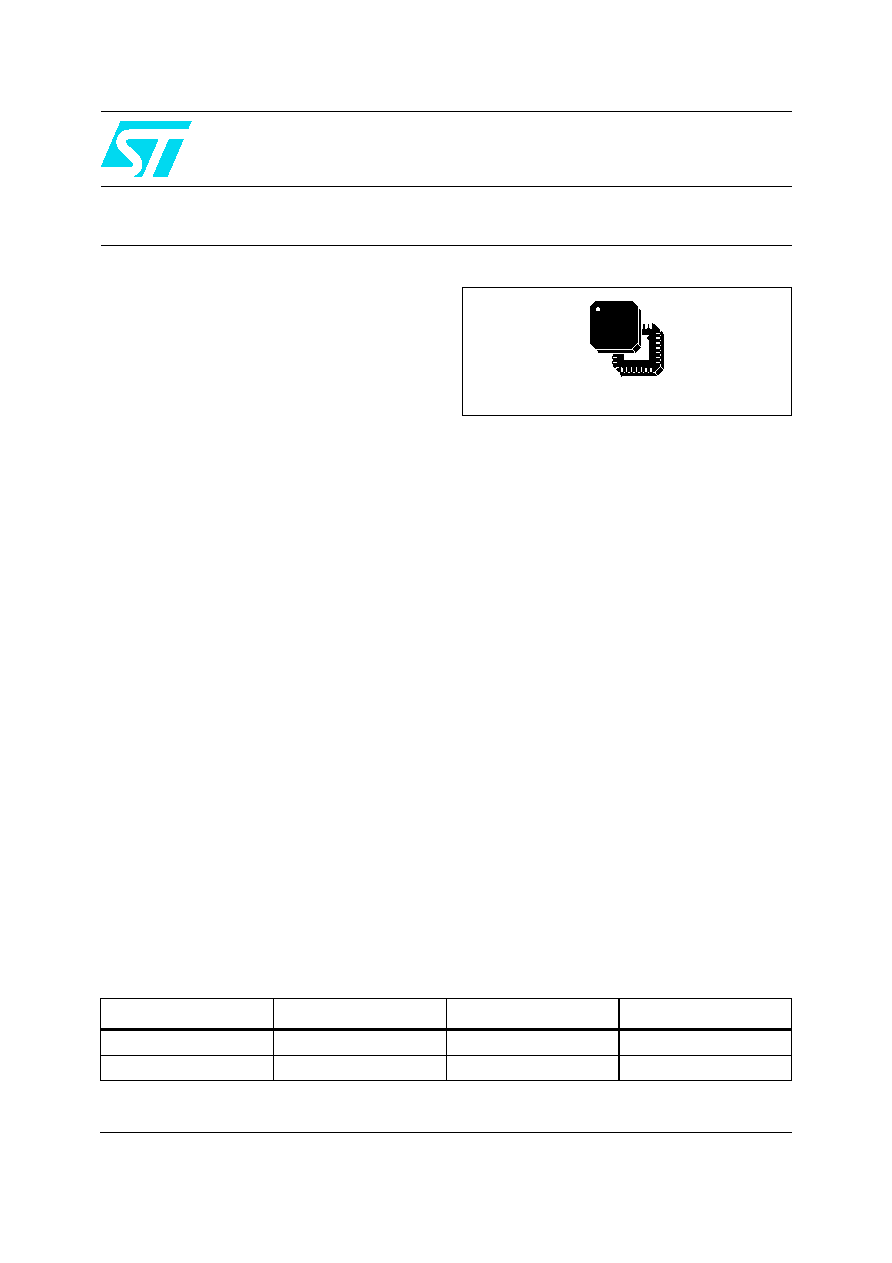
Preliminary Data
This is preliminary information on a new product now in development or undergoing evaluation. Details are subject to
change without notice.
March 2006
Rev 1
1/42
1
STW81101
Multi-band RF frequency synthesizer with integrated VCOs
Feature summary
Integer-N Frequency Synthesizer
Dual differential integrated VCOs with
automatic center frequency calibration:
≠ 3300 - 3900 MHz (Direct output)
≠ 3800 - 4400 MHz (Direct output)
≠ 1650 - 1950 MHz (Internal divider by 2)
≠ 1900 - 2200 MHz (Internal divider by 2)
≠ 825 - 975 MHz (Internal divider by 4)
≠ 950 - 1100 MHz (Internal divider by 4)
Excellent integrated phase noise
Fast lock time: 150µs
Dual modulus programmable prescaler (16/17
or 19/20)
2 programmable counters to achieve a
feedback division ratio from 256 to 65551
(prescaler 16/17) and from 361 to 77836
(prescaler 19/20).
Programmable reference frequency divider (10
bits)
Phase frequency comparator and charge pump
Programmable charge pump current
Digital Lock Detector
Dual Digital Bus Interface: SPI and I
2
C bus with
3 bit programmable address (1100A
2
A
1
A
0
)
3.3V Power Supply
Power down mode (HW and SW)
Small size exposed pad VFQFPN28 package
5x5x1.0mm
Process: BICMOS 0.35µm SiGe
Applications
2.5G and 3G Cellular Infrastructure Equipment
CATV Equipment
Instrumentation and Test Equipment
Other Wireless Communication Systems
Description
The STMicroelectronics STW81101 is an
integrated RF synthesizer with voltage controlled
oscillators (VCOs). Showing high performance,
high integration, low power, and multi-band
performances, STW81101 is a low cost one chip
alternative to discrete PLL and VCOs solutions.
STW81101 includes an Integer-N frequency
synthesizer and two fully integrated VCOs
featuring low phase noise performance and a
noise floor of -154dBc/Hz. The combination of
wide frequency range VCOs (thanks to center-
frequency calibration over 32 sub-bands) and
multiple output options (direct output, divided by 2
or divided by 4) allows to cover the 825MHz-
1100MHz, the 1650MHz-2200MHz and the
3300MHz-4400MHz bands.
The STW81101 is designed with
STMicroelectronics advanced 0.35µm SiGe
process.
Order codes
VFQFPN28
Part number
Temp range,
∞C
Package
Packing
STW81101AT
-40 to 85
VFQFPN28
Tray
STW81101ATR
-40 to 85
VFQFPN28
Tape & Reel
www.st.com

Contents
STW81101
2/42
Contents
1
Block diagram and pin configuration . . . . . . . . . . . . . . . . . . . . . . . . . . . 6
1.1
Block diagram . . . . . . . . . . . . . . . . . . . . . . . . . . . . . . . . . . . . . . . . . . . . . . . 6
1.2
Pin configuration . . . . . . . . . . . . . . . . . . . . . . . . . . . . . . . . . . . . . . . . . . . . . 7
2
Electrical specifications . . . . . . . . . . . . . . . . . . . . . . . . . . . . . . . . . . . . . . 9
2.1
Absolute maximum ratings . . . . . . . . . . . . . . . . . . . . . . . . . . . . . . . . . . . . . 9
2.2
Operating conditions . . . . . . . . . . . . . . . . . . . . . . . . . . . . . . . . . . . . . . . . . 9
2.3
Digital logic levels . . . . . . . . . . . . . . . . . . . . . . . . . . . . . . . . . . . . . . . . . . . . 9
2.4
Electrical characteristics . . . . . . . . . . . . . . . . . . . . . . . . . . . . . . . . . . . . . . 10
2.5
Phase noise specification . . . . . . . . . . . . . . . . . . . . . . . . . . . . . . . . . . . . . 11
3
Typical performance characteristics . . . . . . . . . . . . . . . . . . . . . . . . . . . 14
4
General description . . . . . . . . . . . . . . . . . . . . . . . . . . . . . . . . . . . . . . . . . 16
4.1
Circuit description . . . . . . . . . . . . . . . . . . . . . . . . . . . . . . . . . . . . . . . . . . . 16
4.1.1
Reference input stage . . . . . . . . . . . . . . . . . . . . . . . . . . . . . . . . . . . . . . 16
4.1.2
Reference divider . . . . . . . . . . . . . . . . . . . . . . . . . . . . . . . . . . . . . . . . . . 16
4.1.3
Prescaler . . . . . . . . . . . . . . . . . . . . . . . . . . . . . . . . . . . . . . . . . . . . . . . . 16
4.1.4
A and B counters . . . . . . . . . . . . . . . . . . . . . . . . . . . . . . . . . . . . . . . . . . 17
4.1.5
Phase frequency detector (PFD) . . . . . . . . . . . . . . . . . . . . . . . . . . . . . . 17
4.1.6
Lock detect . . . . . . . . . . . . . . . . . . . . . . . . . . . . . . . . . . . . . . . . . . . . . . 18
4.1.7
Charge pump . . . . . . . . . . . . . . . . . . . . . . . . . . . . . . . . . . . . . . . . . . . . . 18
4.1.8
Voltage controlled oscillators . . . . . . . . . . . . . . . . . . . . . . . . . . . . . . . . . 19
VCO Selection . . . . . . . . . . . . . . . . . . . . . . . . . . . . . . . . . . . . . . . . . . . . . . . . . . .19
VCO Frequency Calibration . . . . . . . . . . . . . . . . . . . . . . . . . . . . . . . . . . . . . . . . .19
VCO Voltage Amplitude Control . . . . . . . . . . . . . . . . . . . . . . . . . . . . . . . . . . . . . .20
5
I
2
C bus interface . . . . . . . . . . . . . . . . . . . . . . . . . . . . . . . . . . . . . . . . . . . 21
5.1
General features . . . . . . . . . . . . . . . . . . . . . . . . . . . . . . . . . . . . . . . . . . . . 21
5.1.1
Power ON reset . . . . . . . . . . . . . . . . . . . . . . . . . . . . . . . . . . . . . . . . . . . 21
5.1.2
Data validity . . . . . . . . . . . . . . . . . . . . . . . . . . . . . . . . . . . . . . . . . . . . . . 21
5.1.3
START condition . . . . . . . . . . . . . . . . . . . . . . . . . . . . . . . . . . . . . . . . . . 21
5.1.4
STOP condition . . . . . . . . . . . . . . . . . . . . . . . . . . . . . . . . . . . . . . . . . . . 21
5.1.5
Byte format and acknowledge . . . . . . . . . . . . . . . . . . . . . . . . . . . . . . . . 22

STW81101
Contents
3/42
5.1.6
Device addressing . . . . . . . . . . . . . . . . . . . . . . . . . . . . . . . . . . . . . . . . . 22
5.1.7
Single-byte write mode . . . . . . . . . . . . . . . . . . . . . . . . . . . . . . . . . . . . . 22
5.1.8
Multi-byte write mode . . . . . . . . . . . . . . . . . . . . . . . . . . . . . . . . . . . . . . . 23
5.1.9
Current byte address read . . . . . . . . . . . . . . . . . . . . . . . . . . . . . . . . . . . 23
5.2
Timing specification . . . . . . . . . . . . . . . . . . . . . . . . . . . . . . . . . . . . . . . . . 23
5.2.1
Ack . . . . . . . . . . . . . . . . . . . . . . . . . . . . . . . . . . . . . . . . . . . . . . . . . . . . . 24
5.3
I
2
C registers . . . . . . . . . . . . . . . . . . . . . . . . . . . . . . . . . . . . . . . . . . . . . . . 25
5.3.1
FUNCTIONAL_MODE . . . . . . . . . . . . . . . . . . . . . . . . . . . . . . . . . . . . . . 25
5.3.2
B_COUNTER . . . . . . . . . . . . . . . . . . . . . . . . . . . . . . . . . . . . . . . . . . . . . 26
5.3.3
A_COUNTER . . . . . . . . . . . . . . . . . . . . . . . . . . . . . . . . . . . . . . . . . . . . . 26
5.3.4
REF_DIVIDER . . . . . . . . . . . . . . . . . . . . . . . . . . . . . . . . . . . . . . . . . . . . 26
5.3.5
CONTROL . . . . . . . . . . . . . . . . . . . . . . . . . . . . . . . . . . . . . . . . . . . . . . . 26
5.3.6
CALIBRATION . . . . . . . . . . . . . . . . . . . . . . . . . . . . . . . . . . . . . . . . . . . . 27
5.3.7
READ-ONLY register . . . . . . . . . . . . . . . . . . . . . . . . . . . . . . . . . . . . . . . 27
5.4
VCO calibration procedure . . . . . . . . . . . . . . . . . . . . . . . . . . . . . . . . . . . . 27
6
SPI digital interface . . . . . . . . . . . . . . . . . . . . . . . . . . . . . . . . . . . . . . . . . 29
6.1
General features . . . . . . . . . . . . . . . . . . . . . . . . . . . . . . . . . . . . . . . . . . . . 29
6.2
Timing specification . . . . . . . . . . . . . . . . . . . . . . . . . . . . . . . . . . . . . . . . . 30
6.3
Bits table . . . . . . . . . . . . . . . . . . . . . . . . . . . . . . . . . . . . . . . . . . . . . . . . . . 31
6.4
VCO calibration procedure . . . . . . . . . . . . . . . . . . . . . . . . . . . . . . . . . . . . 33
7
Application information . . . . . . . . . . . . . . . . . . . . . . . . . . . . . . . . . . . . . 34
7.1
Direct Output . . . . . . . . . . . . . . . . . . . . . . . . . . . . . . . . . . . . . . . . . . . . . . 34
7.2
Divided by 2 Output . . . . . . . . . . . . . . . . . . . . . . . . . . . . . . . . . . . . . . . . . 36
7.3
Divided by 4 Output . . . . . . . . . . . . . . . . . . . . . . . . . . . . . . . . . . . . . . . . . 37
7.4
Evaluation Kit . . . . . . . . . . . . . . . . . . . . . . . . . . . . . . . . . . . . . . . . . . . . . . 38
8
Application diagram . . . . . . . . . . . . . . . . . . . . . . . . . . . . . . . . . . . . . . . . 39
9
Package information . . . . . . . . . . . . . . . . . . . . . . . . . . . . . . . . . . . . . . . . 40
10
Revision history . . . . . . . . . . . . . . . . . . . . . . . . . . . . . . . . . . . . . . . . . . . 41

List of tables
STW81101
4/42
List of tables
Table 1.
Pin description . . . . . . . . . . . . . . . . . . . . . . . . . . . . . . . . . . . . . . . . . . . . . . . . . . . . . . . . . . . 7
Table 2.
Absolute maximum ratings . . . . . . . . . . . . . . . . . . . . . . . . . . . . . . . . . . . . . . . . . . . . . . . . . . 9
Table 3.
Operating conditions . . . . . . . . . . . . . . . . . . . . . . . . . . . . . . . . . . . . . . . . . . . . . . . . . . . . . . . 9
Table 4.
Digital logic levels . . . . . . . . . . . . . . . . . . . . . . . . . . . . . . . . . . . . . . . . . . . . . . . . . . . . . . . . . 9
Table 5.
Electrical characteristics . . . . . . . . . . . . . . . . . . . . . . . . . . . . . . . . . . . . . . . . . . . . . . . . . . . 10
Table 6.
Phase noise specification . . . . . . . . . . . . . . . . . . . . . . . . . . . . . . . . . . . . . . . . . . . . . . . . . . 11
Table 7.
Current value vs selection . . . . . . . . . . . . . . . . . . . . . . . . . . . . . . . . . . . . . . . . . . . . . . . . . 18
Table 8.
Voltage level expected on the resonator nodes . . . . . . . . . . . . . . . . . . . . . . . . . . . . . . . . . 20
Table 9.
Single-byte write mode . . . . . . . . . . . . . . . . . . . . . . . . . . . . . . . . . . . . . . . . . . . . . . . . . . . . 23
Table 10.
Multi-byte write mode . . . . . . . . . . . . . . . . . . . . . . . . . . . . . . . . . . . . . . . . . . . . . . . . . . . . . 23
Table 11.
Current Byte Address Read . . . . . . . . . . . . . . . . . . . . . . . . . . . . . . . . . . . . . . . . . . . . . . . . 23
Table 12.
Data and clock . . . . . . . . . . . . . . . . . . . . . . . . . . . . . . . . . . . . . . . . . . . . . . . . . . . . . . . . . . 23
Table 13.
Start and stop . . . . . . . . . . . . . . . . . . . . . . . . . . . . . . . . . . . . . . . . . . . . . . . . . . . . . . . . . . . 24
Table 14.
Ack . . . . . . . . . . . . . . . . . . . . . . . . . . . . . . . . . . . . . . . . . . . . . . . . . . . . . . . . . . . . . . . . . . . 24
Table 15.
Write-only registers list . . . . . . . . . . . . . . . . . . . . . . . . . . . . . . . . . . . . . . . . . . . . . . . . . . . . 25
Table 16.
Different functional mode of the FUNCTIONAL_MODE register . . . . . . . . . . . . . . . . . . . . 25
Table 17.
SPI data structure (MSB is sent first) . . . . . . . . . . . . . . . . . . . . . . . . . . . . . . . . . . . . . . . . . 30
Table 18.
Address decoder and outputs . . . . . . . . . . . . . . . . . . . . . . . . . . . . . . . . . . . . . . . . . . . . . . . 30
Table 19.
SPI Timing specification . . . . . . . . . . . . . . . . . . . . . . . . . . . . . . . . . . . . . . . . . . . . . . . . . . . 30
Table 20.
Bits . . . . . . . . . . . . . . . . . . . . . . . . . . . . . . . . . . . . . . . . . . . . . . . . . . . . . . . . . . . . . . . . . . . 31
Table 21.
Order code of the evaluation kit . . . . . . . . . . . . . . . . . . . . . . . . . . . . . . . . . . . . . . . . . . . . . 38
Table 22.
Document revision history . . . . . . . . . . . . . . . . . . . . . . . . . . . . . . . . . . . . . . . . . . . . . . . . . 41

STW81101
List of figures
5/42
List of figures
Figure 1.
Block diagram . . . . . . . . . . . . . . . . . . . . . . . . . . . . . . . . . . . . . . . . . . . . . . . . . . . . . . . . . . . . 6
Figure 2.
Pin connection (top view) . . . . . . . . . . . . . . . . . . . . . . . . . . . . . . . . . . . . . . . . . . . . . . . . . . . 7
Figure 3.
VCO A (Direct output) closed loop phase noise at 3.6GHz with F
STEP
=400KHz
(F
PFD
=400KHz). . . . . . . . . . . . . . . . . . . . . . . . . . . . . . . . . . . . . . . . . . . . . . . . . . . . . . . . . . 14
Figure 4.
VCO B (Direct output) closed loop phase noise at 4.0GHz with F
STEP
=400KHz
(F
PFD
=400KHz). . . . . . . . . . . . . . . . . . . . . . . . . . . . . . . . . . . . . . . . . . . . . . . . . . . . . . . . . . 14
Figure 5.
VCO A (Div. by 2 output) closed loop phase noise at 1.8GHz with F
STEP
=200KHz
(F
PFD
=400KHz). . . . . . . . . . . . . . . . . . . . . . . . . . . . . . . . . . . . . . . . . . . . . . . . . . . . . . . . . . 14
Figure 6.
VCO B (Div. by 2 output) closed loop phase noise at 2.0GHz with F
STEP
=200KHz
(F
PFD
=400KHz). . . . . . . . . . . . . . . . . . . . . . . . . . . . . . . . . . . . . . . . . . . . . . . . . . . . . . . . . . 14
Figure 7.
VCO A (Div. by 4 output) closed loop phase noise at 900MHz with F
STEP
=100KHz
(F
PFD
=400KHz). . . . . . . . . . . . . . . . . . . . . . . . . . . . . . . . . . . . . . . . . . . . . . . . . . . . . . . . . . 15
Figure 8.
VCO B (Div. by 4 output) closed loop phase noise at 1.0GHz with F
STEP
=100KHz
(F
PFD
=400KHz). . . . . . . . . . . . . . . . . . . . . . . . . . . . . . . . . . . . . . . . . . . . . . . . . . . . . . . . . . 15
Figure 9.
PFD Frequency Spurs (Div. by 2 Output; F
PFD
=400KHz) . . . . . . . . . . . . . . . . . . . . . . . . . 15
Figure 10.
PFD Frequency Spurs (Div. by 4 Output; F
PFD
=400KHz) . . . . . . . . . . . . . . . . . . . . . . . . . 15
Figure 11.
Reference Frequency Input Buffer . . . . . . . . . . . . . . . . . . . . . . . . . . . . . . . . . . . . . . . . . . . 16
Figure 12.
VCO Divider Diagram . . . . . . . . . . . . . . . . . . . . . . . . . . . . . . . . . . . . . . . . . . . . . . . . . . . . . 17
Figure 13.
PFD diagram. . . . . . . . . . . . . . . . . . . . . . . . . . . . . . . . . . . . . . . . . . . . . . . . . . . . . . . . . . . . 18
Figure 14.
Loop filter connection . . . . . . . . . . . . . . . . . . . . . . . . . . . . . . . . . . . . . . . . . . . . . . . . . . . . . 19
Figure 15.
VCO Sub-Bands Frequency Characteristics . . . . . . . . . . . . . . . . . . . . . . . . . . . . . . . . . . . 19
Figure 16.
Data validity . . . . . . . . . . . . . . . . . . . . . . . . . . . . . . . . . . . . . . . . . . . . . . . . . . . . . . . . . . . . 21
Figure 17.
Start and Stop condition . . . . . . . . . . . . . . . . . . . . . . . . . . . . . . . . . . . . . . . . . . . . . . . . . . . 22
Figure 18.
Byte format and acknowledge . . . . . . . . . . . . . . . . . . . . . . . . . . . . . . . . . . . . . . . . . . . . . . 22
Figure 19.
Data and clock . . . . . . . . . . . . . . . . . . . . . . . . . . . . . . . . . . . . . . . . . . . . . . . . . . . . . . . . . . 23
Figure 20.
Start and stop . . . . . . . . . . . . . . . . . . . . . . . . . . . . . . . . . . . . . . . . . . . . . . . . . . . . . . . . . . . 24
Figure 21.
Ack . . . . . . . . . . . . . . . . . . . . . . . . . . . . . . . . . . . . . . . . . . . . . . . . . . . . . . . . . . . . . . . . . . . 24
Figure 22.
SPI input and output bit order . . . . . . . . . . . . . . . . . . . . . . . . . . . . . . . . . . . . . . . . . . . . . . . 29
Figure 23.
SPI Timing specification . . . . . . . . . . . . . . . . . . . . . . . . . . . . . . . . . . . . . . . . . . . . . . . . . . . 30
Figure 24.
Differential/single ended output network in the 3.3 - 4.4GHz range
(MATCH_LC_LUMP_4G_DIFF.dsn). . . . . . . . . . . . . . . . . . . . . . . . . . . . . . . . . . . . . . . . . . 34
Figure 25.
LC lumped balun and matching network (MATCH_LC_LUMP_4G.dsn) . . . . . . . . . . . . . . 35
Figure 26.
Microstrip line and lumped matching network (MATCH_4G_HYBRID.dsn) . . . . . . . . . . . . 35
Figure 27.
Differential/single ended output network in the 1.65 - 2.2GHz range
(MATCH_LC_LUMP_2G_DIFF.dsn) . . . . . . . . . . . . . . . . . . . . . . . . . . . . . . . . . . . . . . . . . 36
Figure 28.
LC lumped balun for divided by 2 output (MATCH_LC_LUMP_2G.dsn) . . . . . . . . . . . . . . 36
Figure 29.
Lumped output matching for divided by 2 output (MATCH_LC_BAL_2G.dsn) . . . . . . . . . 37
Figure 30.
LC lumped balun for the divided by 4 output (MATCH_LC_LUMP_1G.dsn) . . . . . . . . . . . 37
Figure 31.
Lumped output matching for divided by 4 output (MATCH_LC_BAL_1G.dsn) . . . . . . . . . 38
Figure 32.
Application diiagram . . . . . . . . . . . . . . . . . . . . . . . . . . . . . . . . . . . . . . . . . . . . . . . . . . . . . . 39
Figure 33.
VFQFPN28 Mechanical Data & Package Dimensions . . . . . . . . . . . . . . . . . . . . . . . . . . . . 40
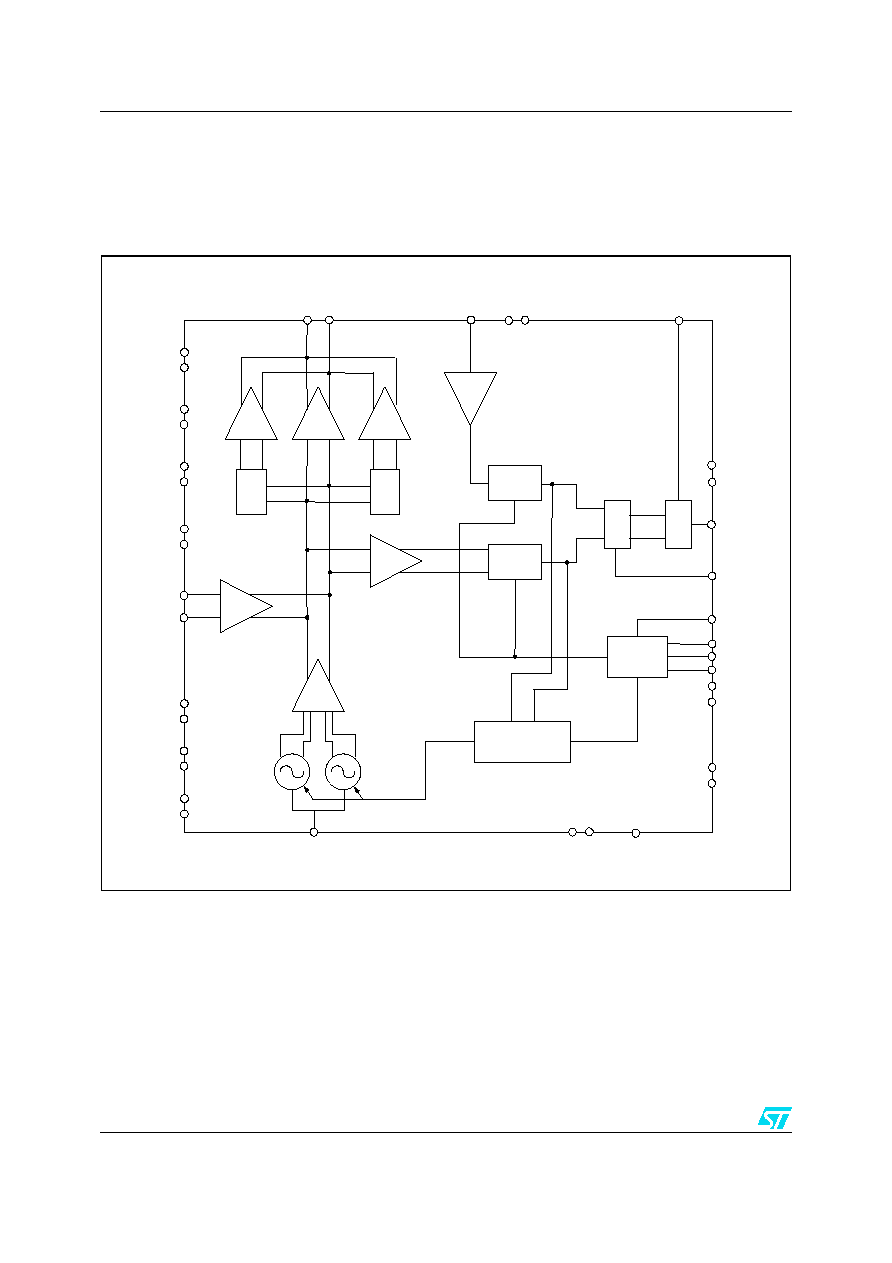
Block diagram and pin configuration
STW81101
6/42
1
Block diagram and pin configuration
1.1 Block
diagram
Figure 1.
Block diagram
VCO
BUFF
VDD_VCOA
VC
T
R
L
EXTVCO_INN
EXTVCO_INP
DI
V
4
DI
V
2
DI
V
4
BU
F
DI
V
2
BU
F
EXT
VCO BUF
VSS_VCOA
VDD_VCOB
VSS_VCOB
VDD_BUFVCO
VSS_BUFVCO
VDD_OUTBUF
VSS_OUTBUF
VDD_DIV4
VSS_DIV4
VDD_DIV2
VSS_DIV2
VDD_ESD
VSS_ESD
ADD0 / LOAD
ADD1
ADD2
VDD_DBUS
VSS_DBUS
VCO
Divider
REF
Divider
BUF
P
F
D
C
P
UP
DN
ICP
LOCK_DET
BUF
VDD_CP
VSS_CP
DBUS
SDA / DATA
SCL / CLK
DBUS_SEL
VCO
Calibrator
VC
O
B
UF
TE
S
T
1
EX
T
_
PD
TE
S
T
2
OUT
B
U
F
P
OUT
B
UFN
REF
_
CLK
VDD_P
L
L
VS
S_
PLL
RE
XT
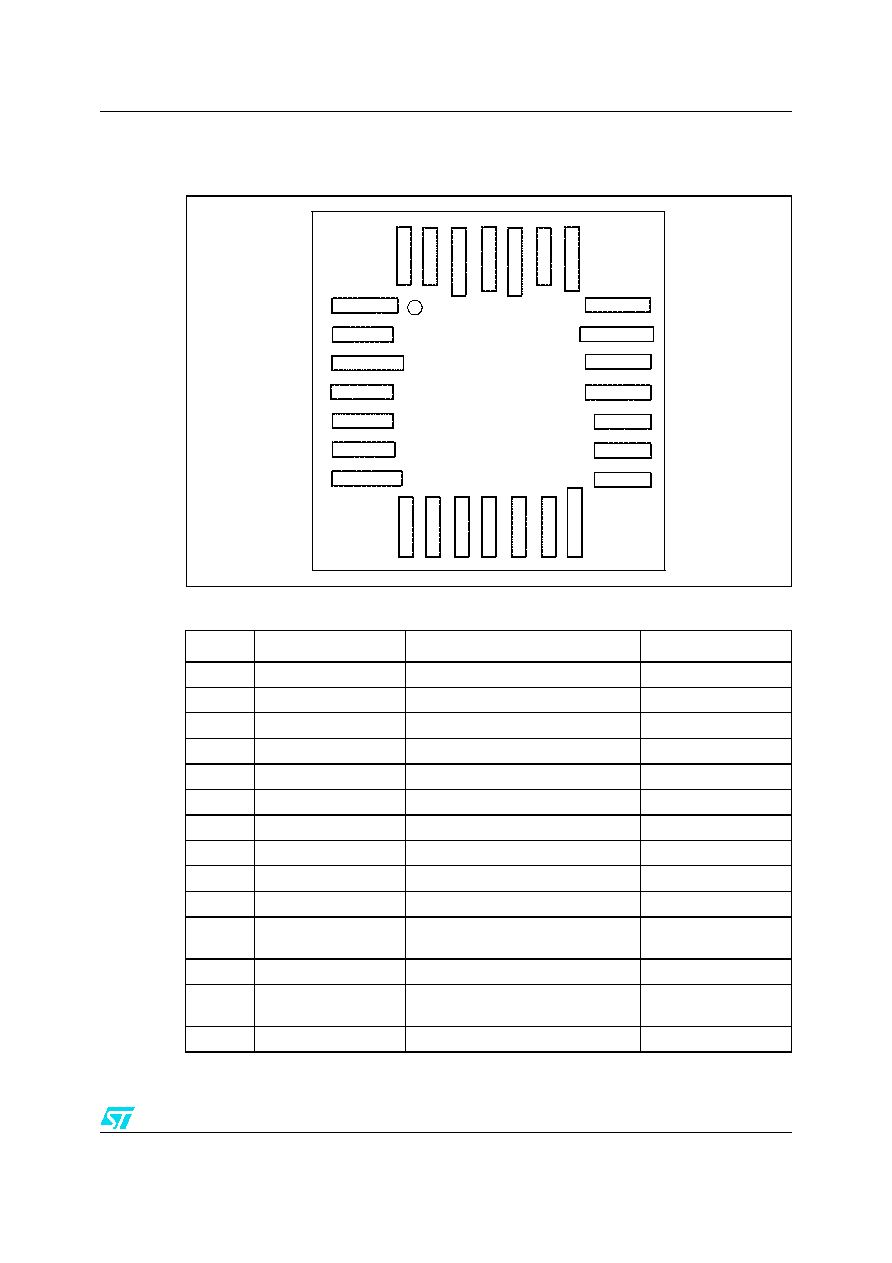
STW81101
Block diagram and pin configuration
7/42
1.2 Pin
configuration
Figure 2.
Pin connection (top view)
Table 1.
Pin description
Pin No
Name
Description
Observation
1
VDD_VCOA
VCOA power supply
2
VDD_DIV2
Divider by 2 power supply
3
VDD_OUTBUF
Output buffer power supply
4
OUTBUFP
LO buffer positive output
Open collector
5
OUTBUFN
LO buffer negative output
Open collector
6
VDD_DIV4
Divider by 4 power supply
7
VDD_VCOB
VCOB power supply
8
VDD_ESD
ESD positive rail power supply
9
VCTRL
VCO control voltage
10
ICP
PLL charge pump output
11
REXT
External resistance connection for
PLL charge pump
12
VDD_CP
Power supply for charge pump
13
TEST1
Test input 1
Test purpose only; must
be connected to GND
14
LOCK_DET
Lock detector
CMOS Output
VFQFPN28
OUTBUFN
VDD_DIV4
VDD_DIV2
VDD_OUTBUF
SC
L
/
C
L
K
AD
D
1
VD
D
_D
B
US
VDD_BUFVCO
EXTVCO_INN
VDD_PLL
IC
P
RE
X
T
TEST2
VD
D
_
ESD
VC
T
R
L
VDD_VCOB
REF_CLK
VDD_VCOA
V
DD_
CP
T
EST
1
LO
C
K
_D
E
T
DBUS_SEL
AD
D
0
/
LO
AD
AD
D2
EX
T_
P
D
OUTBUFP
SD
A
/
DA
T
A
EXTVCO_INP
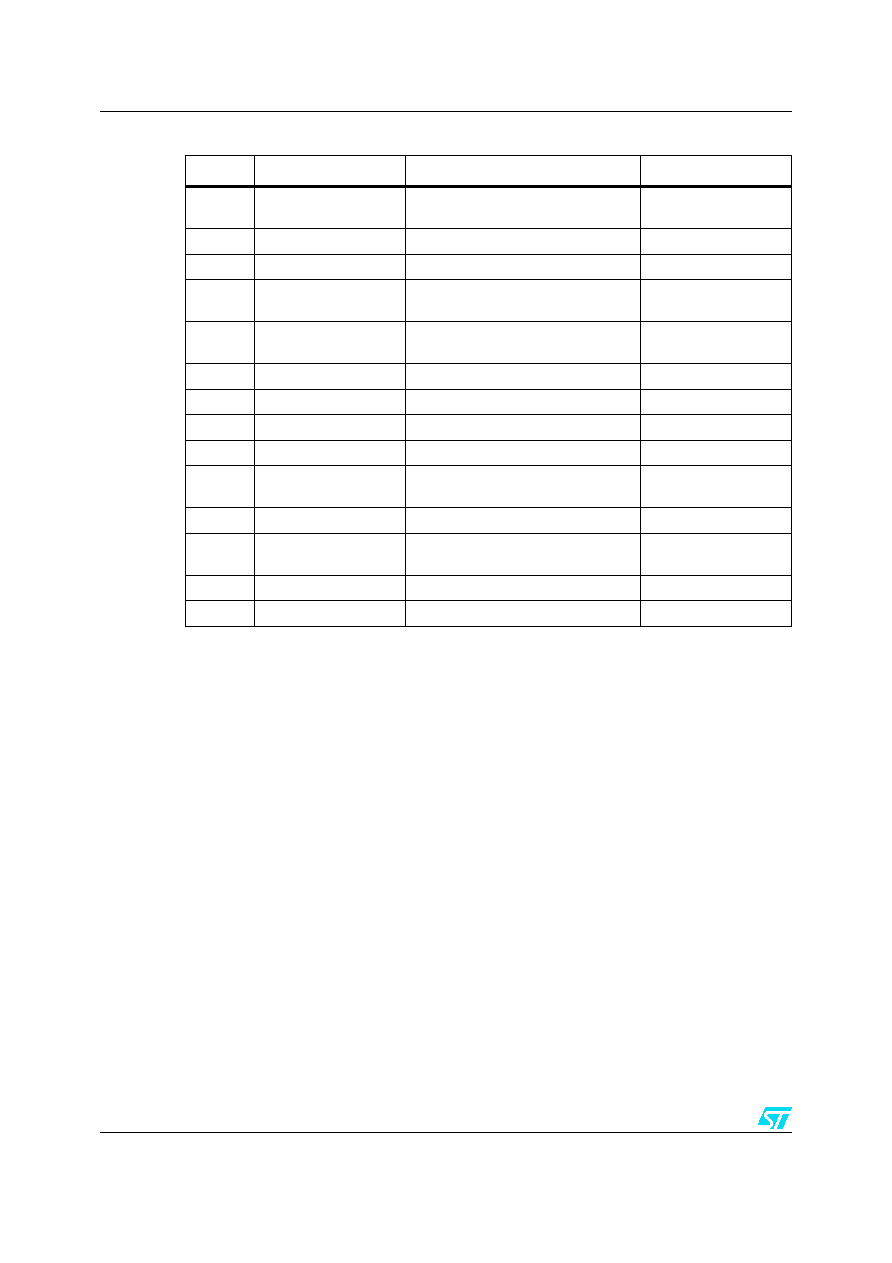
Block diagram and pin configuration
STW81101
8/42
15
TEST2
Test input 2
Test purpose only; must
be connected to GND
16
REF_CLK
Reference clock input
17
VDD_PLL
PLL digital power supply
18
EXTVCO_INN
External VCO negative input
Test purpose only; must
be connected to GND
19
EXTVCO_INP
External VCO positive input
Test purpose only; must
be connected to GND
20
VDD_BUFVCO
VCO buffer power supply
21
DBUS_SEL
Digital Bus Interface select
CMOS Input
22
VDD_DBUS
SPI and I
2
C bus power supply
23
EXT_PD
Power down hardware
CMOS Input
24
SDA/DATA
I2CBUS/SPI data line
CMOS Bidir Schmitt
triggered
25
SCL/CLK
I2CBUS/SPI clock line
CMOS Input
26
ADD0/LOAD
I2CBUS address select pin/ SPI load
line
CMOS Input
27
ADD1
I2CBUS address select pin
CMOS Input
28
ADD2
I2CBUS address select pin
CMOS Input
Table 1.
Pin description (continued)
Pin No
Name
Description
Observation
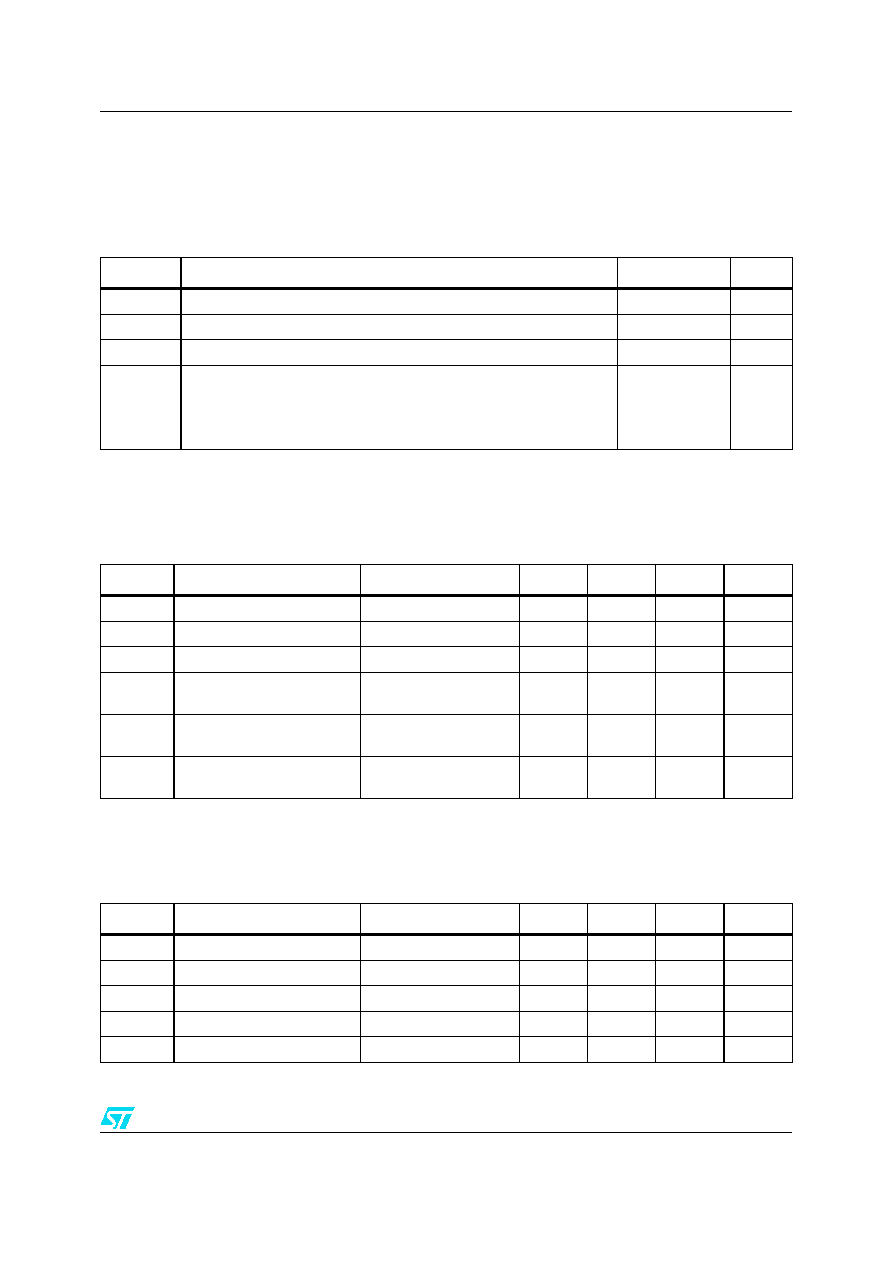
STW81101
Electrical specifications
9/42
2 Electrical
specifications
2.1
Absolute maximum ratings
2.2 Operating
conditions
2.3 Digital
logic
levels
Table 2.
Absolute maximum ratings
Symbol
Parameter
Values
Unit
AV
CC
Analog Supply voltage
0 to 4.6
V
DV
CC
Digital Supply voltage
0 to 4.6
V
T
stg
Storage temperature
+150
∞C
ESD
Electrical Static Discharge
- HBM
(1)
- CDM-JEDEC Standard
- MM
4
1.5
0.2
KV
1.
The maximum rating of the ESD protection circuitry on pin 4 and pin 5 is 1KV.
Table 3.
Operating conditions
Symbol
Parameter
Test conditions
Min
Typ
Max
Unit
AV
CC
Analog Supply voltage
3.0
3.3
3.6
V
DV
CC
Digital
Supply
voltage
3.0
3.3
3.6
V
I
CC
Current Consumption
100
mA
T
amb
Operating ambient
temperature
-40
85
∞C
T
j
Maximum junction
temperature
125
∞C
R
th j-amb
Junction to ambient package
thermal resistance
Multilayer JEDEC board
35
∞C/W
Table 4.
Digital logic levels
Symbol
Parameter
Test conditions
Min
Typ
Max
Unit
V
il
Low level input voltage
0.2*Vdd
V
V
ih
High level input voltage
0.8*Vdd
V
V
hyst
Schmitt trigger hysteresis
0.8
V
V
ol
Low level output voltage
0.4
V
V
oh
High level output voltage
0.85*Vdd
V
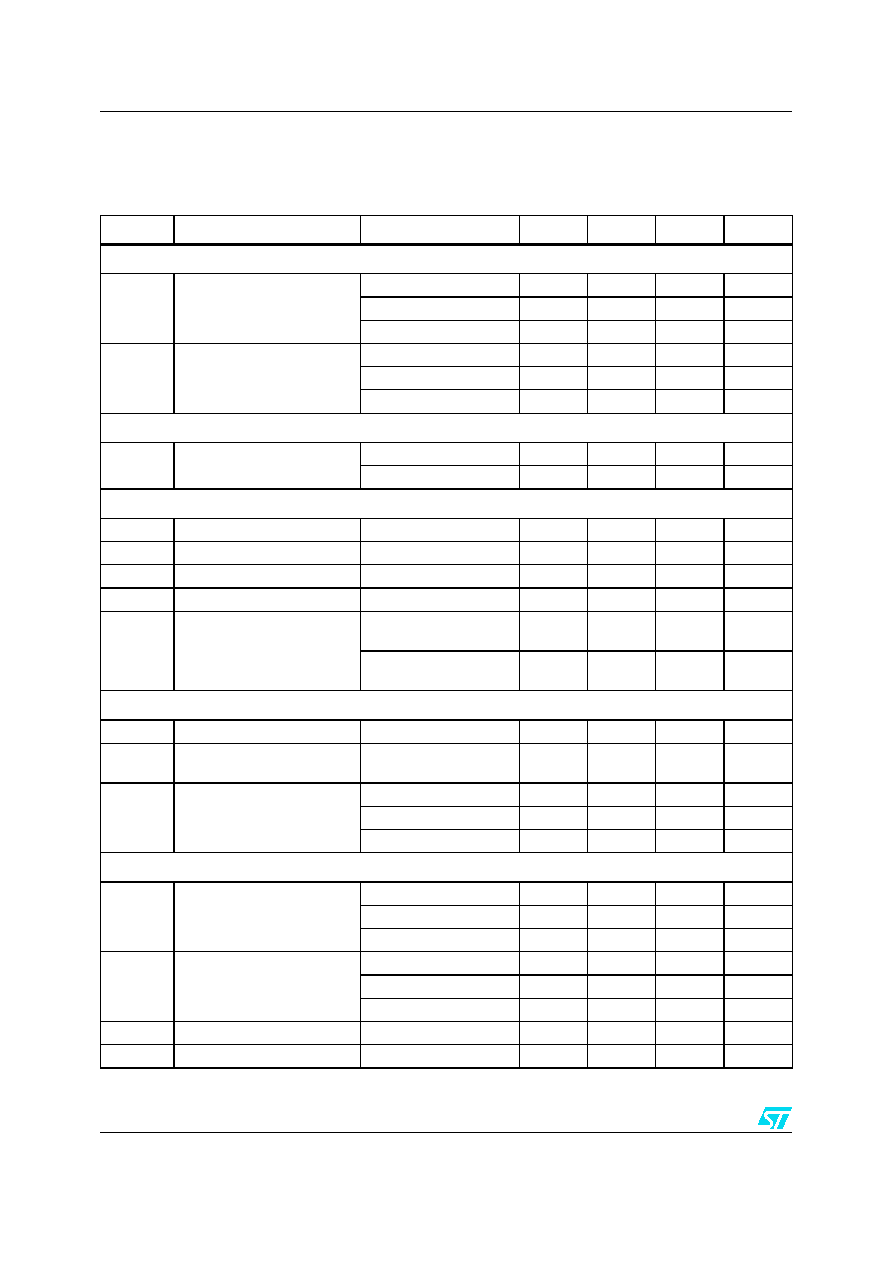
Electrical specifications
STW81101
10/42
2.4 Electrical
characteristics
Table 5.
Electrical characteristics
All the Electrical Specifications are intended at 3.3V supply Voltage.
Symbol
Parameter
Test conditions
Min
Typ
Max
Unit
OUTPUT FREQUENCY RANGE
F
OUTA
Output Frequency Range with
VCOA
Direct Output
3300
3900
MHz
Divider by 2
1650
1950
MHz
Divider by 4
825
975
MHz
F
OUTB
Output Frequency Range with
VCOB
Direct Output
3800
4400
MHz
Divider by 2
1900
2200
MHz
Divider by 4
950
1100
MHz
VCO DIVIDERS
N
VCO Divider Ratio
Prescaler 16/17
256
65551
Prescaler 19/20
361
77836
REFERENCE CLOCK and PHASE FREQUENCY DETECTOR
f
ref
Reference input frequency
10
200
MHz
Reference input sensitivity
0.35
1
1.5
Vpeak
R
Reference Divider Ratio
2
1023
f
PFD
PFD input frequency
16
MHz
f
step
Frequency step
(1)
Prescaler 16/17
F
OUT
/
65551
F
OUT
/
256
Hz
Prescaler 19/20
F
OUT
/
77836
F
OUT
/
361
Hz
CHARGE PUMP
I
CP
ICP sink/source
(2)
3bit programmable
5
mA
V
OCP
Output voltage compliance
range
0.4
V
dd
-0.3
V
Spurious
(3)
Direct Output
-76
dBc
Divider by 2
-82
dBc
Divider by 4
-88
dBc
VCOs
K
VCOA
VCOA sensitivity
(4)
Sub-Band 00000
90
105
115
MHz/V
Sub-Band 01111
55
70
85
MHz/V
Sub-Band 11111
35
45
55
MHz/V
K
VCOB
VCOB sensitivity
(4)
Sub-Band 00000
90
105
115
MHz/V
Sub-Band 01111
55
70
85
MHz/V
Sub-Band 11111
35
45
55
MHz/V
VCO A Pushing
(4)
8
12
MHz/V
VCO B Pushing
(4)
8
12
MHz/V
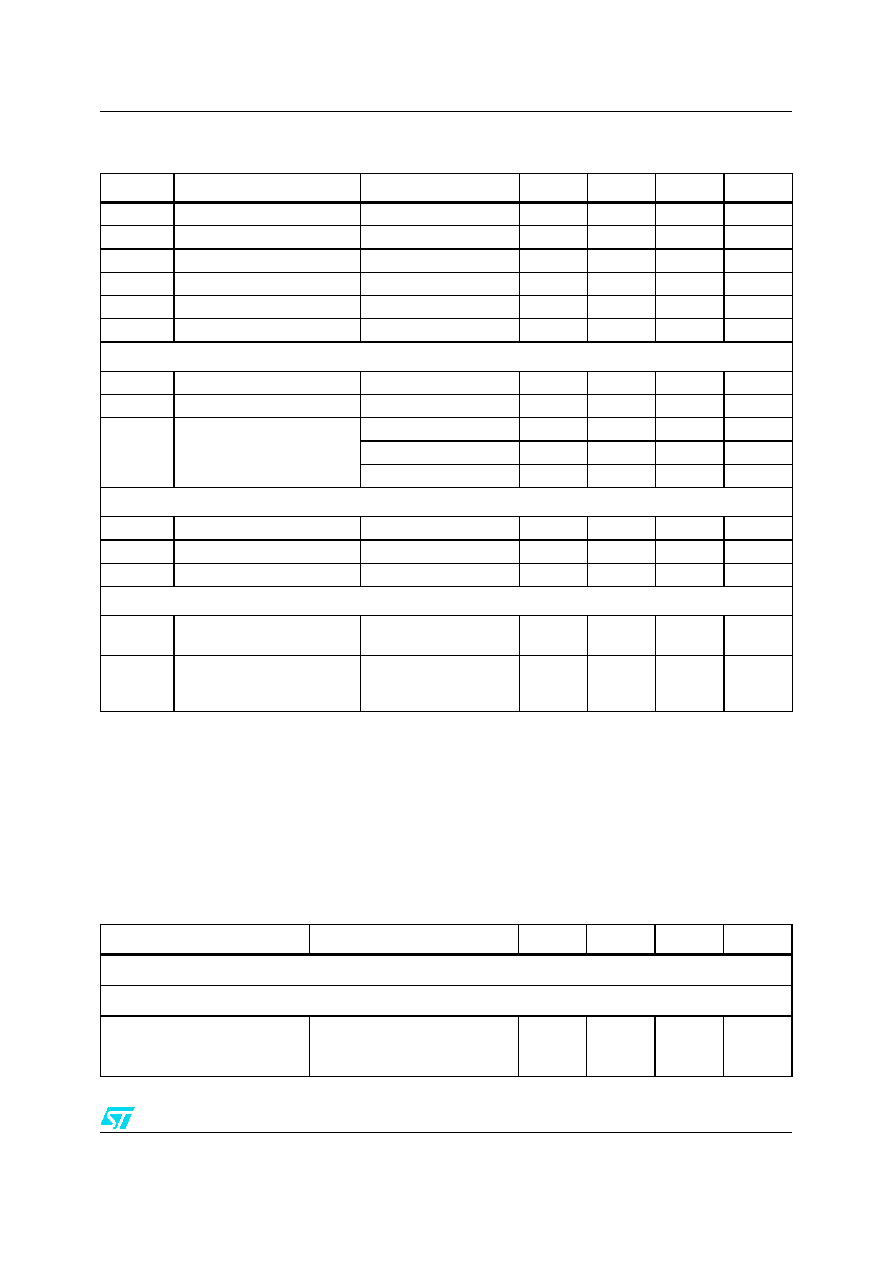
STW81101
Electrical specifications
11/42
2.5
Phase noise specification
V
CTRL
VCO control voltage
(4)
0.4
3
V
LO Harmonic Spurious
(4)
-20
dBc
VCO current consumption
25
mA
VCO buffer consumption
15
mA
DIVIDER by 2 consumption
18
mA
DIVIDER by 4 consumption
14
mA
LO OUTPUT BUFFER
Output level
0
dBm
Return Loss
(4)
Matched to 50ohm
15
dB
Current Consumption
DIV4 Buff
26
mA
DIV2 Buff
23
mA
Direct Output
37
mA
EXTERNAL VCO (Test purpose only)
Frequency range
3.3
4.4
GHz
Input level
0
+6
dBm
Current Consumption
VCO Internal Buffer
15
µA
PLL MISCELLANEOUS
Current Consumption
Input Buffer, Prescaler,
Digital Dividers, misc.
12
mA
Lock up time
(4)
40 KHz PLL bandwidth;
within 1 ppm of
frequency error
150
µs
1.
The frequency step is related to the PFD input frequency as follows:
- f
step
= f
PFD
for Direct Output
- f
step
= f
PFD
/2 for Divided by 2 Output
- f
step
= f
PFD
/4 for Divided by 4 Output
2.
see relationship between ICP and REXT in the Circuit Description section (Charge Pump)
3.
PFD frequency leakage (400KHz) and harmonics
4.
Guaranteed by design and characterization.
Table 5.
Electrical characteristics (continued)
All the Electrical Specifications are intended at 3.3V supply Voltage.
Symbol
Parameter
Test conditions
Min
Typ
Max
Unit
Table 6.
Phase noise specification
Parameter
Test conditions
Min
Typ
Max
Unit
PHASE NOISE PERFORMANCE
(1)
In Band Phase Noise Floor ≠ Closed Loop
(2)
Normalized In Band Phase Noise
Floor
ICP=4mA, PLL BW = 50KHz;
including reference clock
contribution
-220
dBc/Hz
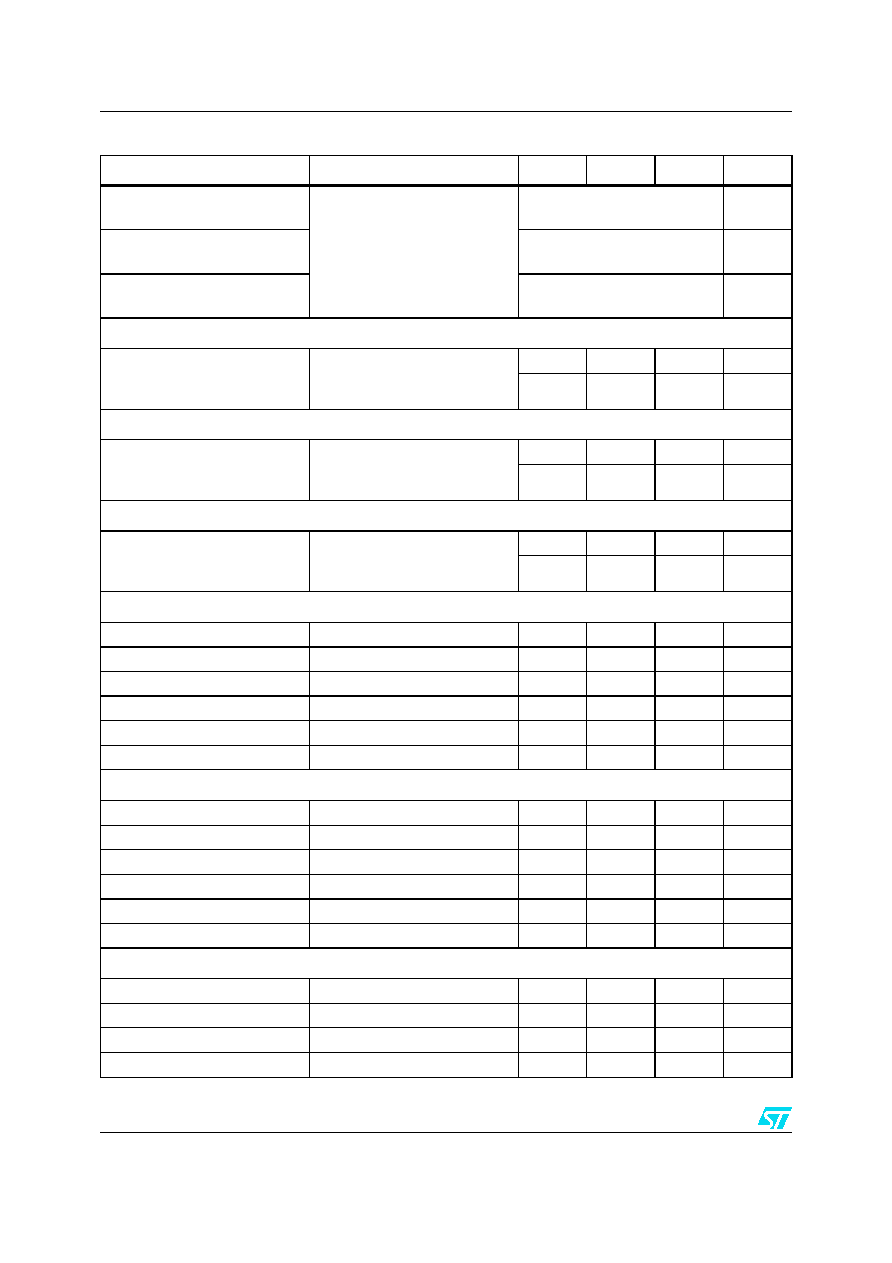
Electrical specifications
STW81101
12/42
In Band Phase Noise Floor
Direct Output
ICP=4mA, PLL BW = 50KHz;
including reference clock
contribution
-220+20log(N)+10log(
f
PFD
)
dBc/Hz
In Band Phase Noise Floor
Divider by 2
-
226+20log(N)+10log(
f
PFD
)
dBc/Hz
In Band Phase Noise Floor
Divider by 4
-
232+20log(N)+10log(
f
PFD
)
dBc/Hz
PLL Integrated Phase Noise ≠ Direct Output
Integrated Phase Noise
100Hz to 40MHz
F
OUT
= 4 GHz,
f
PFD
= 400KHz, f
STEP
=400 KHz,
PLL BW = 35KHz, ICP=4mA
-38
dBc
1.0
∞ rms
PLL Integrated Phase Noise ≠ Divider by 2
Integrated Phase Noise
100Hz to 40MHz
F
OUT
= 2 GHz,
f
PFD
= 400KHz, f
STEP
=200 KHz,
PLL BW = 35KHz, ICP=4mA
-44
dBc
0.5
∞ rms
PLL Integrated Phase Noise ≠ Divider by 4
Integrated Phase Noise
100Hz to 40MHz
F
OUT
= 1 GHz,
f
PFD
= 400KHz, f
STEP
=100 KHz,
PLL BW = 35KHz, ICP=4mA
-50
dBc
0.25
∞ rms
VCO A Direct (3300MHz-3900MHz) ≠ Open Loop
(3)
Phase Noise @ 1 KHz
-56
dBc/Hz
Phase Noise @ 10 KHz
-83
dBc/Hz
Phase Noise @ 100 KHz
-105
dBc/Hz
Phase Noise @ 1 MHz
-128
dBc/Hz
Phase Noise @ 10 MHz
-148
dBc/Hz
Phase Noise @ 40 MHz
-156
dBc/Hz
VCO B Direct (3800MHz-4400MHz) ≠ Open Loop
(3)
Phase Noise @ 1 KHz
-55
dBc/Hz
Phase Noise @ 10 KHz
-82
dBc/Hz
Phase Noise @ 100 KHz
-104
dBc/Hz
Phase Noise @ 1 MHz
-127
dBc/Hz
Phase Noise @ 10 MHz
-147
dBc/Hz
Phase Noise @ 40 MHz
-155
dBc/Hz
VCO A with divider by 2 (1650MHz-1950MHz) ≠ Open Loop
(3)
Phase Noise @ 1 KHz
-62
dBc/Hz
Phase Noise @ 10 KHz
-89
dBc/Hz
Phase Noise @ 100 KHz
-111
dBc/Hz
Phase Noise @ 1 MHz
-134
dBc/Hz
Table 6.
Phase noise specification (continued)
Parameter
Test conditions
Min
Typ
Max
Unit

STW81101
Electrical specifications
13/42
Upon request an Evaluation Kit is available including a powerful simulation tool
(STWPLLSim) which allows to estimate very accurately the Phase Noise of the device
according to the desired project parameters (VCO Frequency, Selected Output Stage,
Reference Clock, Frequency Step, ...); refer to the Application Information (
Section 7
) for
more details.
Phase Noise @ 10 MHz
-150
dBc/Hz
Phase Noise @ 20 MHz
-152
dBc/Hz
Phase Noise Floor @ 40 MHz
-154
dBc/Hz
VCO B with divider by 2 (1900MHz-2200MHz) ≠ Open Loop
(3)
Phase Noise @ 1 KHz
-61
dBc/Hz
Phase Noise @ 10 KHz
-88
dBc/Hz
Phase Noise @ 100 KHz
-110
dBc/Hz
Phase Noise @ 1 MHz
-133
dBc/Hz
Phase Noise @ 10 MHz
-150
dBc/Hz
Phase Noise @ 20 MHz
-152
dBc/Hz
Phase Noise Floor @ 40 MHz
-154
dBc/Hz
VCO A with divider by 4 (825MHz-975MHz) ≠ Open Loop
(3)
Phase Noise @ 1 KHz
-68
dBc/Hz
Phase Noise @ 10 KHz
-95
dBc/Hz
Phase Noise @ 100 KHz
-117
dBc/Hz
Phase Noise @ 1 MHz
-139
dBc/Hz
Phase Noise @ 10 MHz
-151
dBc/Hz
Phase Noise Floor @ 40 MHz
-154
dBc/Hz
VCO B with divider by 4 (950MHz-1100MHz) ≠ Open Loop
(3)
Phase Noise @ 1 KHz
-67
dBc/Hz
Phase Noise @ 10 KHz
-94
dBc/Hz
Phase Noise @ 100 KHz
-116
dBc/Hz
Phase Noise @ 1 MHz
-138
dBc/Hz
Phase Noise @ 10 MHz
-151
dBc/Hz
Phase Noise Floor @ 40
MHz
-154
dBc/Hz
1.
Phase Noise SSB.
VCO amplitude setting to value [10].
All the closed-loop performances are specified using a Reference Clock signal at 76.8 MHz with phase noise of
-135dBc/Hz @1KHz offset, -145dBc/Hz @10KHz offset and -149.5dBc/Hz of noise floor.
2.
Normalized PN = Measured PN ≠ 20log(N) ≠ 10log(f
PFD
) where N is the VCO divider ratio (N=B*P+A) and f
PFD
is the
comparison frequency at the PFD input
3.
Typical Phase Noise at centre band frequency
Table 6.
Phase noise specification (continued)
Parameter
Test conditions
Min
Typ
Max
Unit
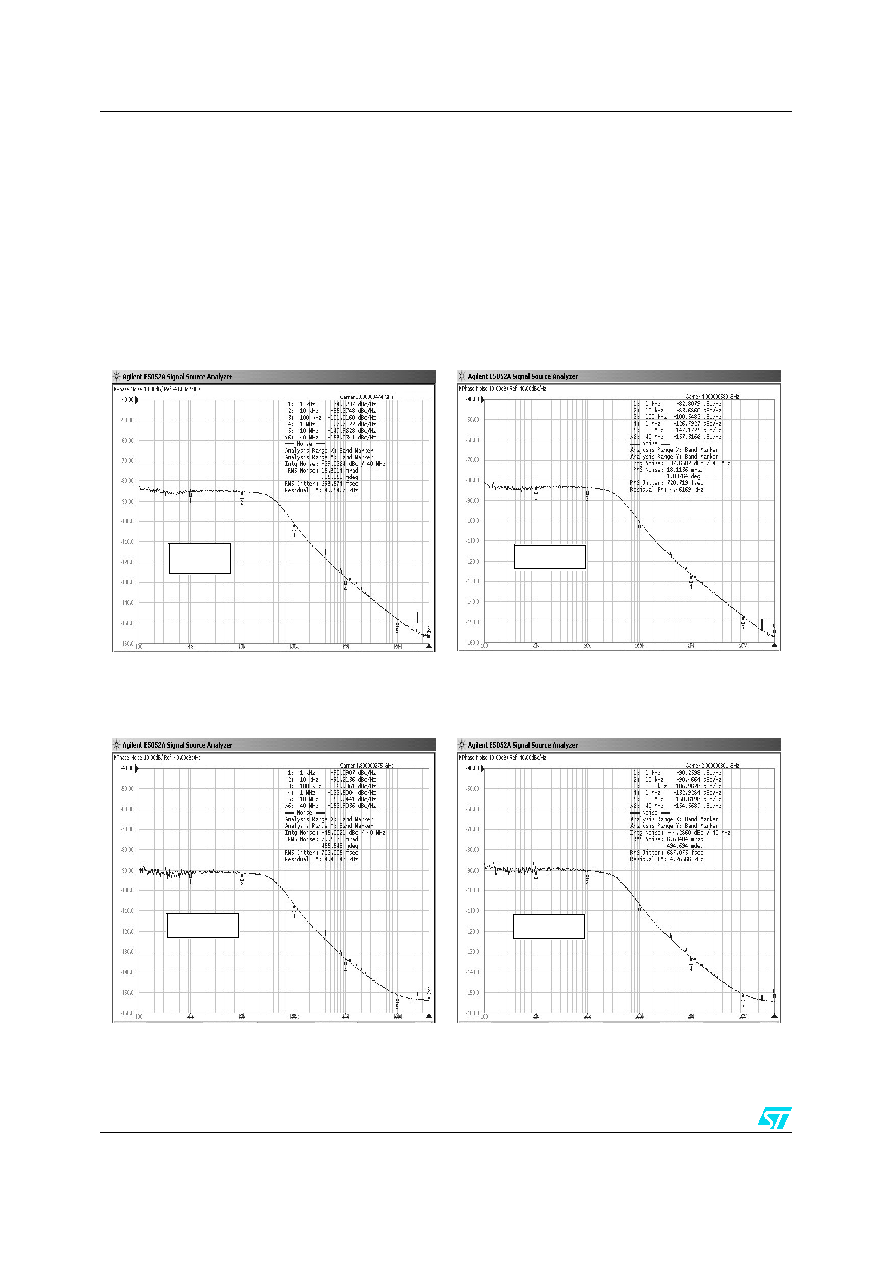
Typical performance characteristics
STW81101
14/42
3
Typical performance characteristics
The phase noise is measured with the Agilent E5052A Signal Source Analyzer. All the
closed-loop measurements are done with f
PFD
= 400 KHz and using a Reference Clock
signal at 76.8 MHz with phase noise of -135dBc/Hz @1KHz offset, -145dBc/Hz @10KHz
offset and -149.5dBc/Hz @1KHz of noise floor.
Figure 3.
VCO A (Direct output) closed loop
phase noise at 3.6GHz with
F
STEP
=400KHz (F
PFD
=400KHz)
Figure 4.
VCO B (Direct output) closed loop
phase noise at 4.0GHz with
F
STEP
=400KHz (F
PFD
=400KHz)
Figure 5.
VCO A (Div. by 2 output) closed
loop phase noise at 1.8GHz with
F
STEP
=200KHz (F
PFD
=400KHz)
Figure 6.
VCO B (Div. by 2 output) closed
loop phase noise at 2.0GHz with
F
STEP
=200KHz (F
PFD
=400KHz)
0.9∞ rms
1.0∞ rms
0.45∞ rms
0.5∞ rms
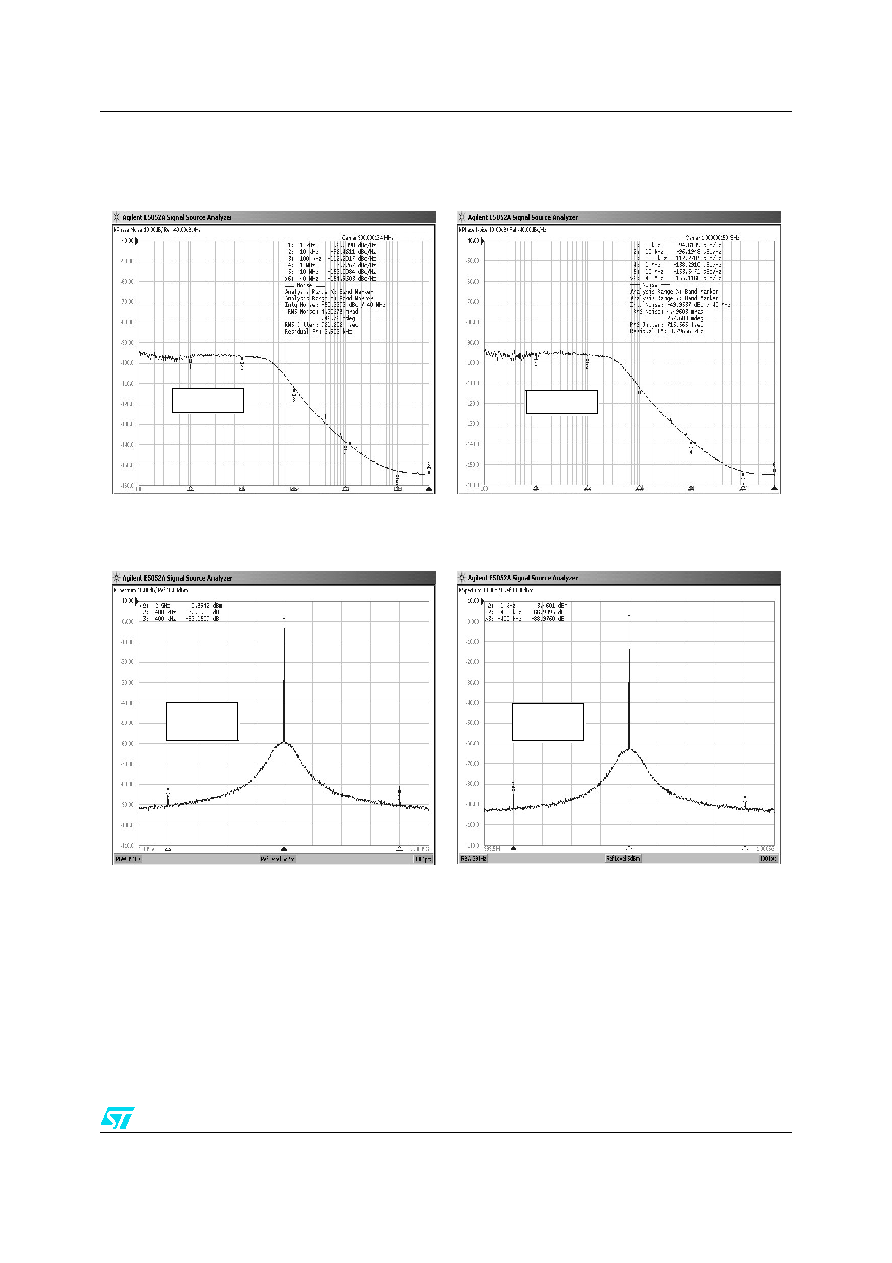
STW81101
Typical performance characteristics
15/42
Figure 7.
VCO A (Div. by 4 output) closed
loop phase noise at 900MHz with
F
STEP
=100KHz (F
PFD
=400KHz)
Figure 8.
VCO B (Div. by 4 output) closed
loop phase noise at 1.0GHz with
F
STEP
=100KHz (F
PFD
=400KHz)
Figure 9.
PFD Frequency Spurs (Div. by 2
Output; F
PFD
=400KHz)
Figure 10.
PFD Frequency Spurs (Div. by 4
Output; F
PFD
=400KHz)
0.24∞ rms
0.25∞ rms
-82 dBc
@400KHz
-89 dBc
@400KHz

General description
STW81101
16/42
4 General
description
The block diagram of
Figure 1
shows the different blocks, which have been integrated to
achieve an integer-N PLL frequency synthesizer.
The STW81101 consists of 2 internal low-noise VCOs with buffer blocks, a divider by 2, a
divider by 4, a low-noise PFD (Phase Frequency Detector), a precise charge pump, a 10-bit
programmable reference divider, two programmable counters and a programmable dual-
modulus prescaler. The A-counter (5 bits) and B counter (12 bits) counters, in conjunction
with the dual modulus prescaler P/P+1 (16/17 or 19/20), implement an N integer divider,
where N = B*P +A. The division ratio of both reference and VCO dividers is controlled
through the selected digital interface (I
2
C bus or SPI).
The selection of the digital interface type is done by the proper hardware connection of the
pin DBUS_SEL (0 V for I
2
C bus, 3.3 V for SPI).
All devices operate with a power supply of 3.3 V and can be powered down when not in use.
4.1 Circuit
description
4.1.1
Reference input stage
The reference input stage is shown in
Figure 11
. The resistor network feeds a DC bias at the
Fref input while the inverter used as the frequency reference buffer is AC coupled.
Figure 11.
Reference Frequency Input Buffer
4.1.2 Reference
divider
The 10-bit programmable reference counter allows the input reference frequency to be
divided to produce the input clock to the PFD. The division ratio is programmed through the
digital interface.
4.1.3 Prescaler
The dual-modulus prescaler P/P+1 takes the CML clock from the VCO buffer and divides it
down to a manageable frequency for the CMOS A and B counters. The modulus (P) is
programmable and can be set to 16 or 19. It is based on a synchronous 4/5 core which
division ratio depends on the state of the modulus input.
INV
BUF
VDD
Fref
Power Down
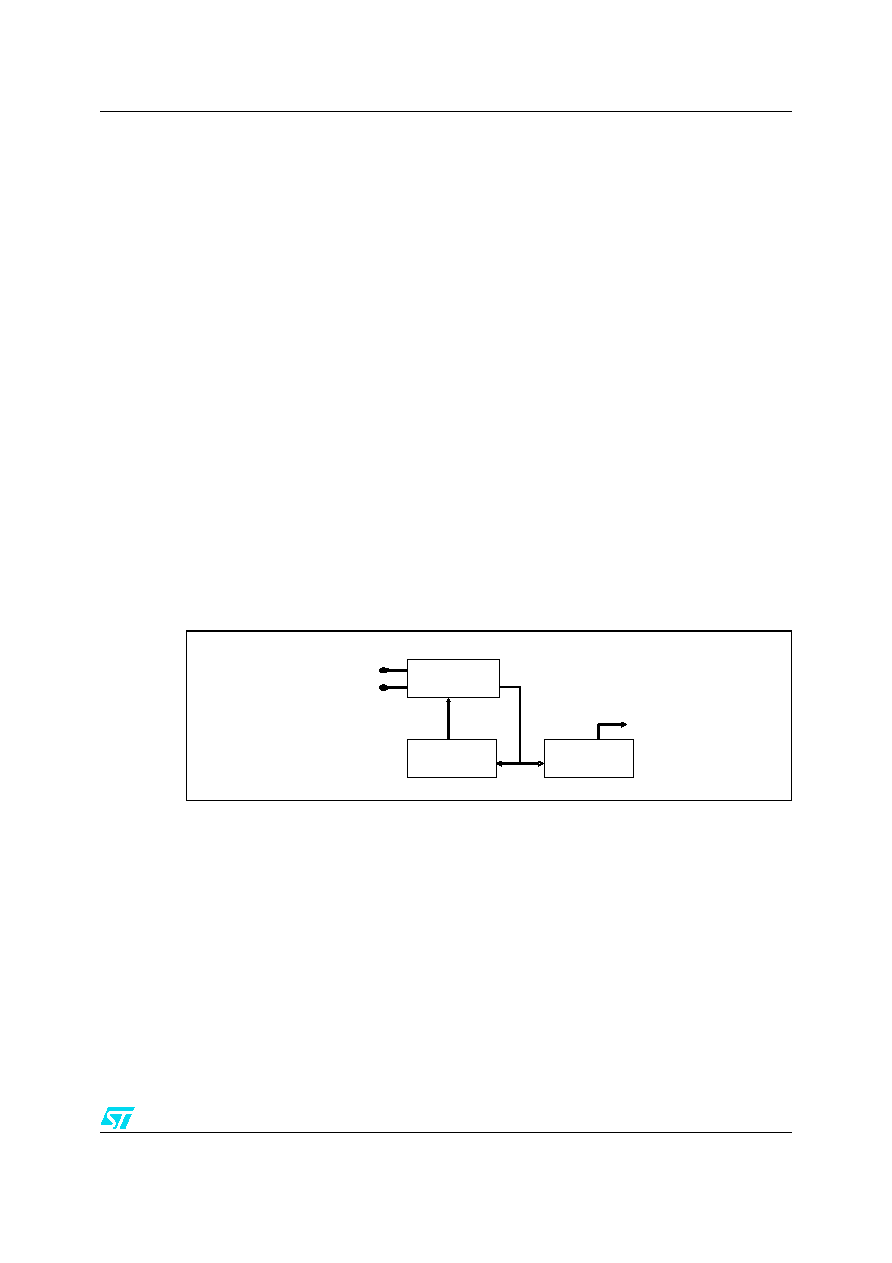
STW81101
General description
17/42
4.1.4
A and B counters
The A (5 bits) and B (12 bits) counters, in conjunction with the selected dual modulus (16/17
or 19/20) prescaler make it possible to generate output frequencies which are spaced only
by the reference frequency divided by the reference division ratio. Thus, the division ratio
and the VCO output frequency are given by these formulas:
N = B ∑ P + A
where:
F
vco
: output frequency of VCO.
P: modulus of dual modulus prescaler (16 or 19 selected through the digital interface).
B: division ratio of the main counter.
A: division ratio of the swallow counter.
F
ref
: input reference frequency.
R: division ratio of reference counter.
N: division ratio of PLL
For a correct work of the VCO divider, B must be strictly higher than A. A can take any value
ranging from 0 to 31. The range of the N number can vary from 256 to 65551 (P=16) or from
361 to 77836 (P=19).
Figure 12.
VCO Divider Diagram
4.1.5
Phase frequency detector (PFD)
The PFD takes inputs from the reference and the VCO dividers and produces an output
proportional to the phase error. The PFD includes a delay gate that controls the width of the
anti-backlash pulse. This pulse ensures that there is no dead zone in the PFD transfer
function.
Figure 13
is a simplified schematic of the PFD.
F
vco
B P
A
+
(
) F
ref
R
------------------------------------------
=
5 bit
A counter
12 bit
B counter
To PFD
modulus
VCOBUF+
VCOBUF-
Prescaler
16/17 or 19/20
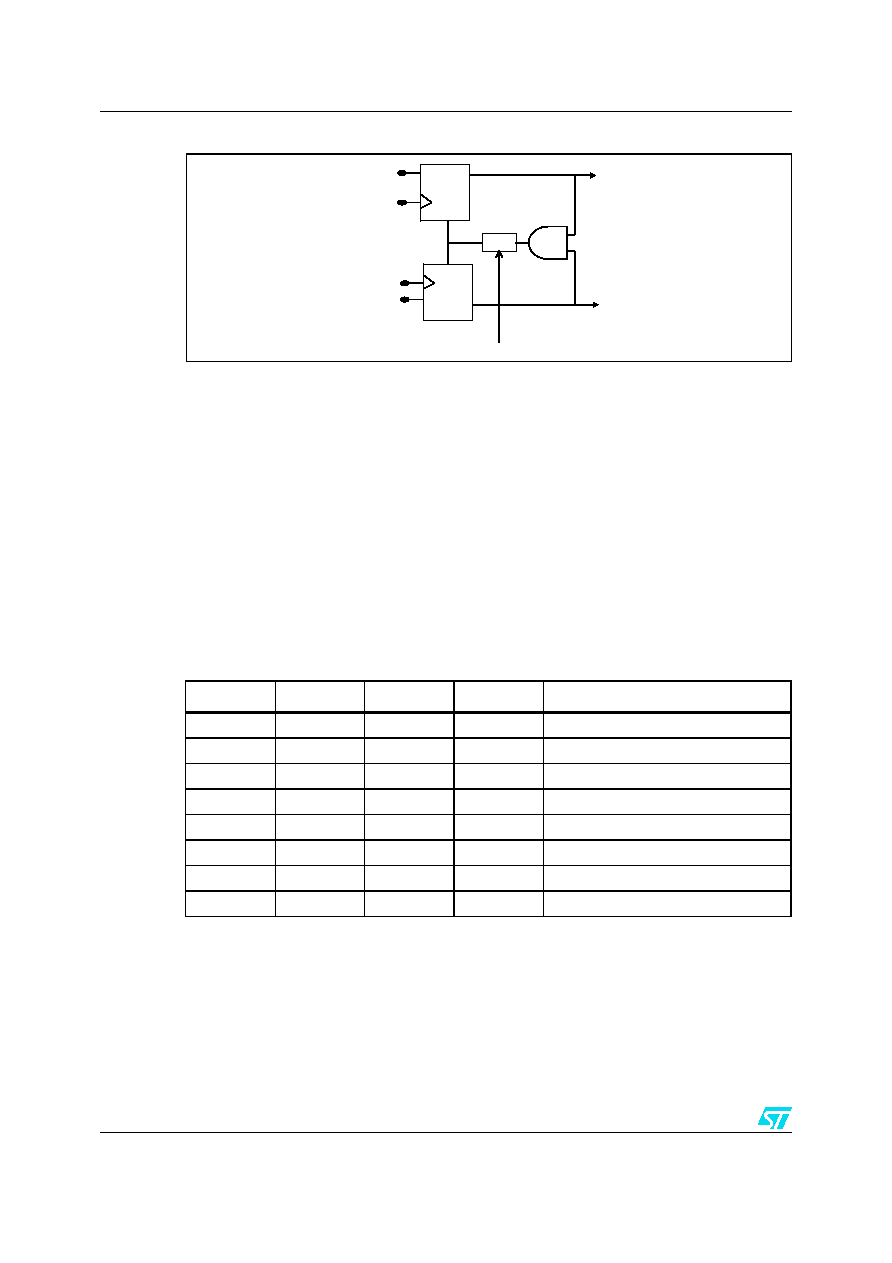
General description
STW81101
18/42
Figure 13.
PFD diagram
4.1.6 Lock
detect
This signal indicates that the difference between rising edges of both UP and DOWN PFD
signals is found to be shorter than the fixed delay (roughly 5 ns). Lock Detect signal is high
when the PLL is locked. When Power Down is activated, Lock Detect is let to high level
(Lock Detect consumes current only during PLL transients).
4.1.7 Charge
pump
This block drives two matched current sources, Iup and Idown, which are controlled
respectively by UP and DOWN PFD outputs. The nominal value of the output current is
controlled by an external resistor (to be connected to the REXT input pin) and a selection
among 8 by a 3 bit word.
The minimum value of the output current is: I
MIN
= 2*VBG/REXT (VBG~1.17 V)
Note:
The current is output on pin ICP. During the VCO auto calibration, ICP and VCTRL pins are
forced to VDD/2
D FF
R
Fref
VDD
R
D FF
Fref
VDD
Delay
Up
Down
ABL
Table 7.
Current value vs selection
CPSEL2
CPSEL1
CPSEL0
Current
Value for REXT=4.7 K
0
0
0
I
MIN
0.5 mA
0
0
1
2*I
MIN
1.0 mA
0
1
0
3*I
MIN
1.5 mA
0
1
1
4*I
MIN
2.0 mA
1
0
0
5*I
MIN
2.5 mA
1
0
1
6*I
MIN
3.0 mA
1
1
0
7*I
MIN
3.5 mA
1
1
1
8*I
MIN
4.0 mA

STW81101
General description
19/42
Figure 14.
Loop filter connection
4.1.8
Voltage controlled oscillators
VCO Selection
Within STW81101 two low-noise VCOs are integrated to cover a wide band from 3300MHz
to 4400MHz (direct output), from 1650MHz to 2200MHz (selecting divider by 2) and from
825MHz to 1100MHz (selecting divider by 4).
VCO A frequency range 3300MHz-3900MHz
VCO B frequency range 3800MHz-4400MHz
VCO Frequency Calibration
Both VCOs can operate on 32 frequency ranges that are selected by adding or subtracting
capacitors to the resonator. These frequency ranges are intended to cover the wide band of
operation and compensate for process variation on the VCO center frequency.
An automatic selection of the range is performed when the bit SERCAL rises from "0" to "1".
The charge pump is inhibited and the pins ICP & VCTRL are at VDD/2 volts. Then the
ranges are tested to select the one which with this VCO input voltage is the nearest to the
desired output frequency (Fout = N*Fref/R). When this selection is achieved the signal
ENDCALB (which means End of Calibration) falls to "0", then the charge pump is enabled
again and SERCAL should be reset to "0" before the next channel step. The PLL has just to
perform fine adjustment around VDD/2 on the loop filter to reach Fout, which enables a fast
settle.
Figure 15.
VCO Sub-Bands Frequency Characteristics
Charge
Pump
ICP
VCTRL
BUF
VDD
BUF
Cal bit
R1
C1
C3
R3
C2
C3
R3
C2
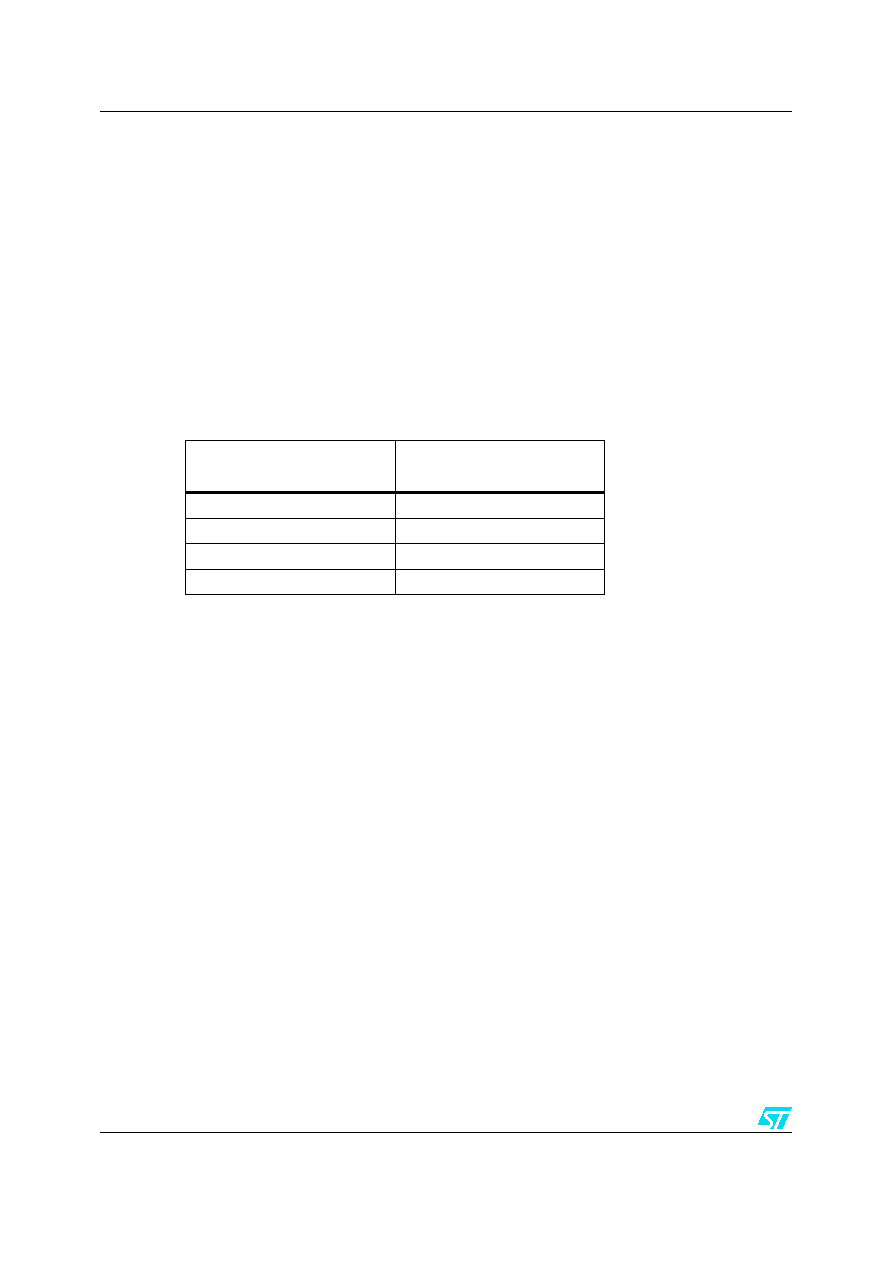
General description
STW81101
20/42
The SERCAL bit should be set to "1" at each division ratio change. It should be noted that in
order to reset the autocalibrator State Machine after a power-up, and anyway before the first
calibration, the INITCAL bit should be set to "1" and back to "0" (this operation is
automatically performed by the Power On Reset circuitry). The calibration takes
approximately 7 periods of the PFD Frequency.
The maximum allowed f
PFD
to perform the calibration process is 1 MHz. Using an higher
F
PFD
the following procedure should be adopted:
1.
Calibrate the VCO at the desired frequency with an f
PFD
less than 1 MHz
2.
Set the A, B and R dividers ratio for the desired f
PFD
VCO Voltage Amplitude Control
The bits A0 and A1 control the voltage swing of the VCO. The following table gives the
voltage level expected on the resonator nodes.
Table 8.
Voltage level expected on the resonator nodes
Code A[1:0]
Differential output
voltage (Vp)
00
1.1
01
1.3
10
1.9
11
2.1

STW81101
I
2
C bus interface
21/42
5 I
2
C bus interface
The I
2
C bus interface is selected by hardware connection of the pin #21 (DBUS_SEL) to 0 V.
Data transmission from microprocessor to the STW81101 takes place through the 2 wires
(SDA and SCL) I
2
C-BUS interface. The STW81101 is always a slave device.
The I
2
C-bus protocol defines any device that sends data on to the bus as a transmitter and
any device that reads the data as receiver. The device that controls the data transfer is
known as the Master and the others as the slave. The master will always initiate the transfer
and will provide the serial clock for synchronization.
5.1 General
features
5.1.1 Power
ON
reset
The device at Power ON is able to configure itself to a fixed configuration, with all
programmable bits set to factory default setting.
5.1.2 Data
validity
Data changes on the SDA line must only occur when the SCL is LOW. SDA transitions while
the clock is HIGH are used to identify START or STOP condition.
Figure 16.
Data validity
5.1.3 START
condition
A Start condition is identified by a HIGH to LOW transition of the data bus SDA while the
clock signal SCL is stable in the HIGH state. A Start condition must precede any command
for data transfer.
5.1.4 STOP
condition
A LOW to HIGH transition of the data bus SDA identifies stop while the clock signal SCL is
stable in the HIGH state. A STOP condition terminates communications between the
STW81101 and the Bus Master.
SDA
SCL
CHANGE
DATA
ALLOWED
DATA LINE
STABLE DATA
VALID
SDA
SCL
CHANGE
DATA
ALLOWED
DATA LINE
STABLE DATA
VALID

I
2
C bus interface
STW81101
22/42
Figure 17.
Start and Stop condition
5.1.5
Byte format and acknowledge
Every byte transferred on the SDA line must contain bits. Each byte must be followed by an
acknowledge bit. The MSB is transferred first.
An acknowledge bit is used to indicate a successful data transfer. The bus transmitter, either
master or slave, will release the SDA bus after sending 8 bits of data. During the 9th clock
pulse the receiver pulls the SDA low to acknowledge the receipt of 8 bits data.
Figure 18.
Byte format and acknowledge
5.1.6 Device
addressing
To start the communication between the Master and the STW81101, the master must
initiate with a start condition. Following this, the master sends onto the SDA line 8 bits (MSB
first) corresponding to the device select address and read or write mode.
The first 7 MSB's are the device address identifier, corresponding to the I
2
C-Bus definition.
For the STW81101 the address is set as "1100A
2
A
1
A
0
", 3bits programmable. The 8th bit
(LSB) is the read or write operation bit (RW; set to 1 in read mode and to 0 in write mode).
After a START condition the STW81101 identifies on the bus the device address and, if
matched, it will acknowledge the identification on SDA bus during the 9th clock pulse.
5.1.7
Single-byte write mode
Following a START condition the master sends a device select code with the RW bit set to 0.
The STW81101 gives an acknowledge and waits for the internal sub-address (1 byte). This
byte provides access to any of the internal registers.
After the reception of the sub-address internal byte the STW81101 again responds with an
acknowledge. A single-byte write to sub-address 00H will change the
"FUNCTIONAL_MODE" register, so a single-byte write with sub-address 04H will change
the "CONTROL" register and so on.
SDA
SCL
START
STOP
SDA
SCL
START
STOP
SDA
SCL
START
//
//
ACKNOWLEDGMENT
FROM RECEIVER
1
2
3
7
8
9
MSB
SDA
SCL
START
//
//
ACKNOWLEDGMENT
FROM RECEIVER
1
2
3
7
8
9
MSB

STW81101
I
2
C bus interface
23/42
5.1.8
Multi-byte write mode
The multi-byte write mode can start from any internal address. The master sends the data
bytes and each one is acknowledged. The master terminates the transfer by generating a
STOP condition.
The sub-address decides the starting byte. A multi-byte with sub-address 01H and 2
DATA_IN bytes will change the "B_COUNTER" and "A_COUNTER" registers (01H,02H), so
a multi-byte with sub-address 00H and and 6 DATA_IN bytes will change all the STW81101
registers.
5.1.9
Current byte address read
In the current byte address read mode, following a START condition, the master sends the
device address with the rw bit set to 1 (No sub-address is needed as there is only 1 byte
read register). The STW81101 acknowledges this and outputs the data byte. The master
does not acknowledge the received byte, but terminates the transfer with a STOP condition.
5.2 Timing
specification
Figure 19.
Data and clock
Table 9.
Single-byte write mode
S
1100A
2
A
1
A
0
0
ack
sub-address byte
ack
DATA IN
ack
P
Table 10.
Multi-byte write mode
S
1100A
2
A
1
A
0
0
ack
sub-address byte
ack DATA IN
ack
....
DATA IN
ack
P
Table 11.
Current Byte Address Read
S
1100 A
2
A
1
A
0
1
ack
DATA OUT
No ack
P
Table 12.
Data and clock
Symbol
Parameter
Minimum time (ns)
T
cs
Data to clock set up time
2
T
ch
Data to clock hold time
2
T
cwh
Clock pulse width high
10
T
cwl
Clock pulse width low
5
t
cs
t
ch
t
cwh
t
cwl
SDA
SCL
t
cs
t
ch
t
cwh
t
cwl
SDA
SCL
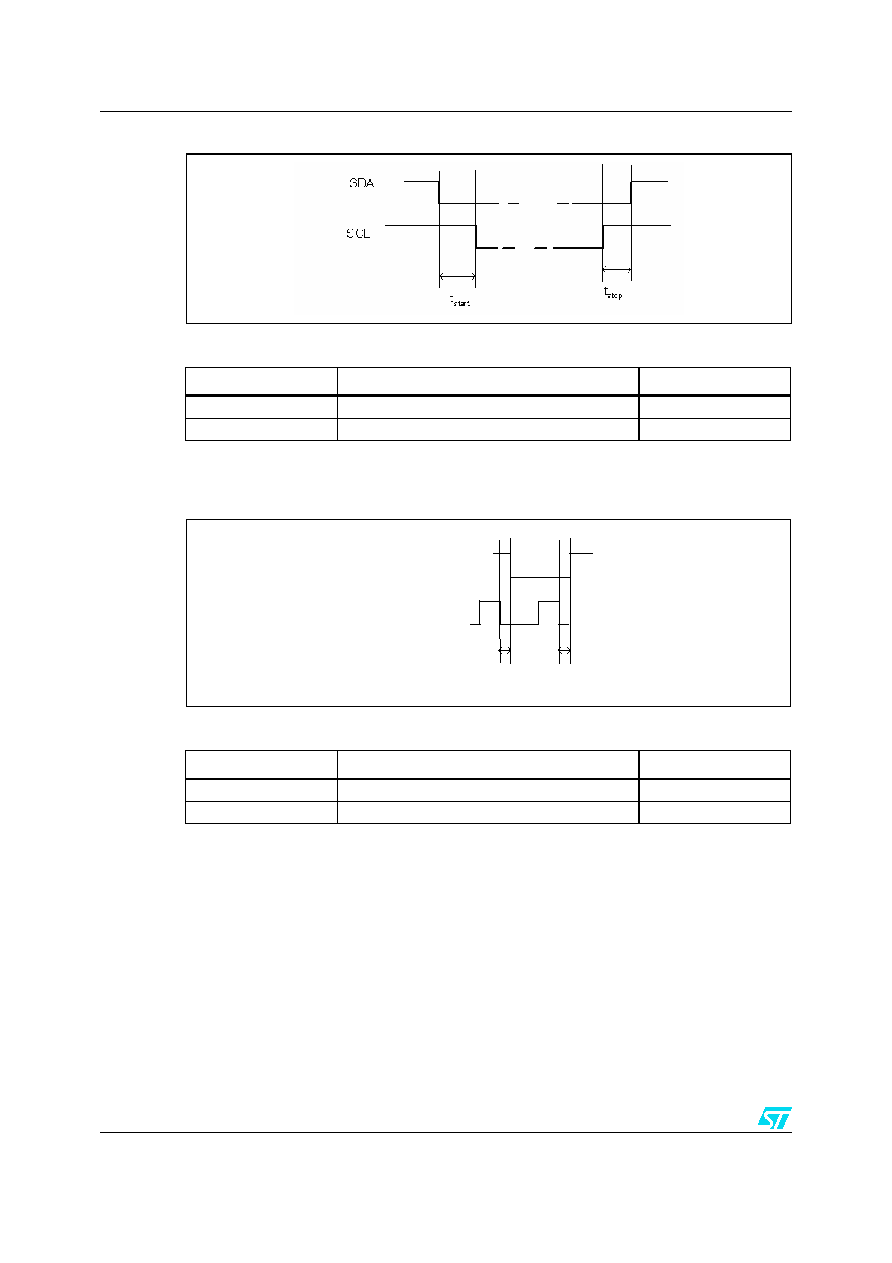
I
2
C bus interface
STW81101
24/42
Figure 20.
Start and stop
5.2.1 Ack
Figure 21.
Ack
Table 13.
Start and stop
Symbol
Parameter
Minimum time (ns)
T
start
Clock to data start time
2
T
stop
Data to clock down stop time
2
Table 14.
Ack
Symbol
Parameter
Minimum time (ns)
T
d1
Ack begin delay
2
T
d2
Ack end delay
2
SDA
SCL
td2
8
9
td1
SDA
SCL
td2
8
9
td1
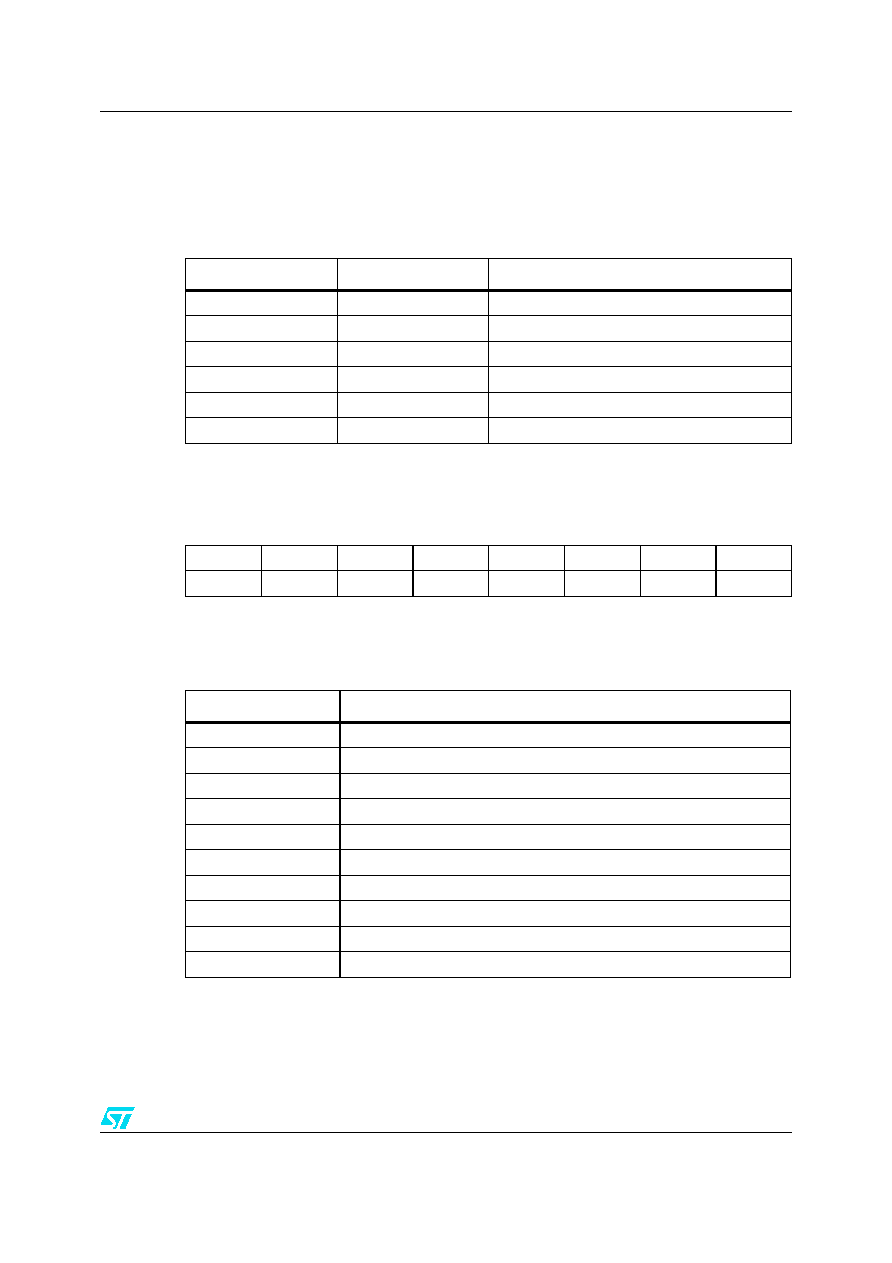
STW81101
I
2
C bus interface
25/42
5.3 I
2
C registers
STW81101 has 6 write-only registers and 1 read-only register.
The following table gives a short description of the write-only registers list.
5.3.1 FUNCTIONAL_MODE
FUNCTIONAL_MODE register is used to select different functional mode for the STW81101
synthesizer according to the following table:
Table 15.
Write-only registers list
HEX CODE
DEC CODE
DESCRIPTION
0x00
0
FUNCTIONAL_MODE
0x01
1
B_COUNTER
0x02
2
A_COUNTER
0x03
3
REF_DIVIDER
0x04
4
CONTROL
0x05
5
CALIBRATION
MSB
LSB
b7
b6
b5
b4
b3
b2
b1
b0
PD6
PD5
PD4
PD3
PD2
PD1
PD0
B11
Table 16.
Different functional mode of the FUNCTIONAL_MODE register
Decimal value
Description
0
Power down mode
1
Enable VCO A, output frequency divided by 2
2
Enable VCO B, output frequency divided by 2
3
Enable external VCO, output frequency divided by 2
4
Enable VCO A, output frequency divided by 4
5
Enable VCO B, output frequency divided by 4
6
Enable external VCO, output frequency divided by 4
7
Enable VCO A, direct output
8
Enable VCO B, direct output
9
Enable external VCO, direct output
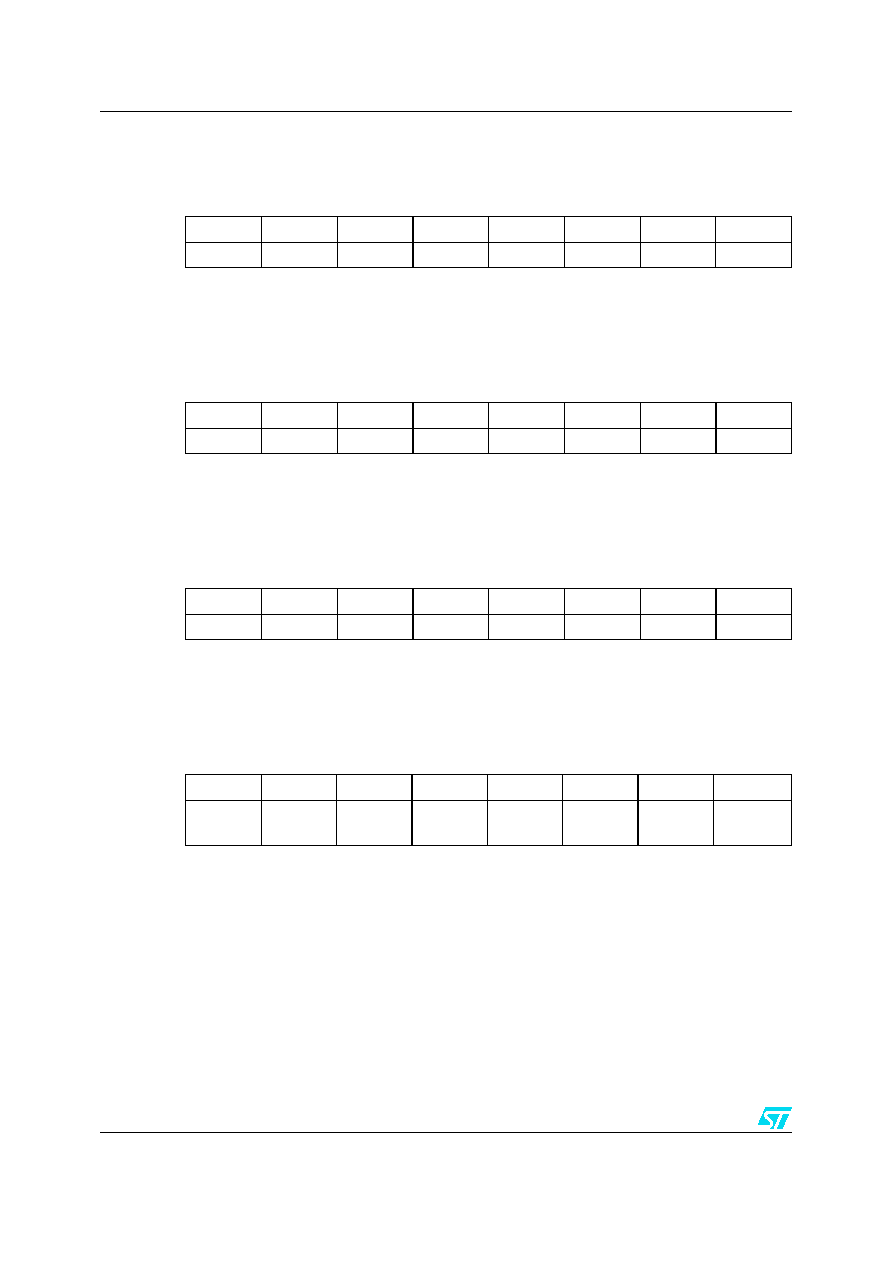
I
2
C bus interface
STW81101
26/42
5.3.2 B_COUNTER
B[10:3]. Counter value (bit B11 in the previous register, bits B[2:0] in the next register)
5.3.3 A_COUNTER
Bits B[2:0] for B Counter, A Counter value.
5.3.4 REF_DIVIDER
Reference Clock divider ratio R[9:1] (bits R1, R0 in the next register).
5.3.5 CONTROL
The CONTROL register is used to set the Charge Pump current, the VCO output voltage
amplitude and the Prescaler Modulus.
PLL_A[1:0]: VCO amplitude
CPSEL[2:0]: Charge Pump output current
PSC_SEL: Prescaler Modulus select ('0' for P=16, '1' for P=19)
The LO output frequency is programmed by setting the proper value for A,B and R
according to the following formula:
MSB
LSB
b7
b6
b5
b4
b3
b2
b1
b0
B10
B9
B8
B7
B6
B5
B4
B3
MSB
LSB
b7
b6
b5
b4
b3
b2
b1
b0
B2
B1
B0
A4
A3
A2
A1
A0
MSB
LSB
b7
b6
b5
b4
b3
b2
b1
b0
R9
R8
R7
R6
R5
R4
R3
R2
MSB
LSB
b7
b6
b5
b4
b3
b2
b1
b0
R1
R0
PLL_
A1
PLL_
A0
CP
SEL2
CP
SEL1
CP
SEL0
PSC_
SEL
F
OUT
D
R
B P
A
+
(
)
F
REF_CLK
R
----------------------------
=
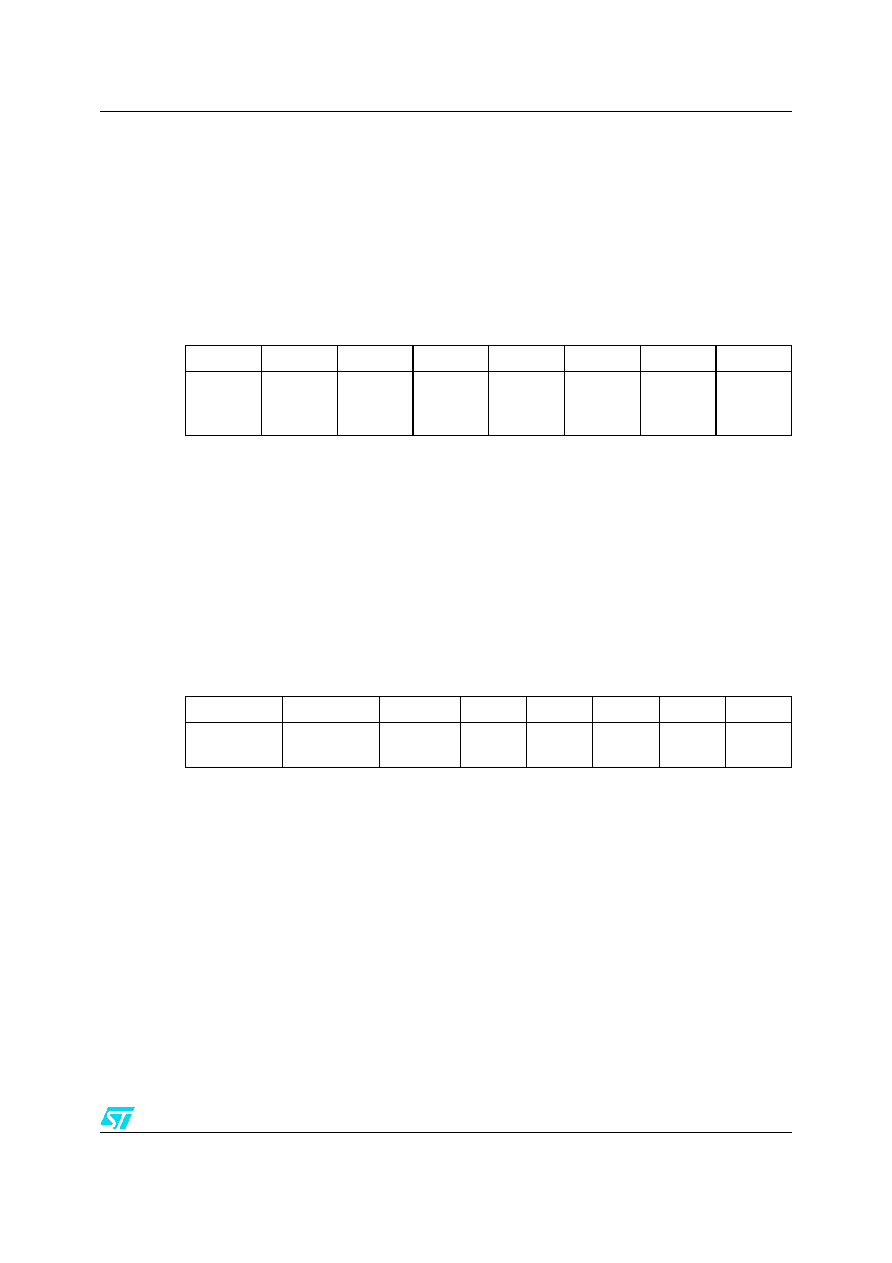
STW81101
I
2
C bus interface
27/42
and P is the selected Prescaler Modulus
5.3.6 CALIBRATION
This register controls VCO calibrator.
INITCAL: resets the auto-calibrator State Machine (writing to "1" and back to "0")
SERCAL: at "1" starts the VCO auto-calibration (should be reset to "0" at the end of
calibration)
SELEXTCAL: test purpose only; must be set to '0'
CAL[4:0]: test purpose only; must be set to '0'
5.3.7 READ-ONLY
register
This register is automatically addressed in the 'current byte address read mode'.
DEV_ID[1:0]: device identifier bits; returns '00'
LOCK_DET: "1" when PLL is locked
INTCAL[4:0]: internal value of the VCO control word
5.4
VCO calibration procedure
The calibration of the VCO center frequency is activated by a '0' to '1' transition of the
SERCAL bit (CALIBRATION Register bit[6]).
In order to program properly the device, ensuring the VCO calibration, the following
procedure is required before every channel change:
a)
Program all the Registers using a multi-byte write sequence with the desired
settings (Functional Mode, B and A counters, R counter, VCO amplitude, Charge
1
for Direct Output
where D
R
equals
0.5
for Output Divided by 2
0.25
for Output Divided by 4
MSB
LSB
b7
b6
b5
b4
b3
b2
b1
b0
INIT
CAL
SER
CAL
SEL
EXT
CAL
CAL4
CAL3
CAL2
CAL1
CAL0
MSB
LSB
b7
b6
b5
b4
b3
b2
b1
b0
DEV_ID1
DEV_ID0
LOCK_
DET
INT
CAL4
INT
CAL3
INT
CAL2
INT
CAL1
INT
CAL0
{

I
2
C bus interface
STW81101
28/42
Pump, Prescaler Modulus) and all the bits of the "CALIBRATION" Register (05H)
set to '0'
b)
Program the "CALIBRATION" Register using a single-byte write sequence (sub-
address 05H) with the SERCAL bit set to '1'
The maximum allowed PFD frequency (f
PFD
) to perform the calibration process is 1 MHz; if
the desired f
PFD
is higher than 1MHz the following steps are needed:
≠
Perform all the steps of the calibration procedure programming the desired VCO
frequency with a proper setting of R, B and A counter so that f
PFD
is
1MHz.
≠
Program the device with the proper setting for the desired VCO and PFD
frequencies according to the above step a) only.
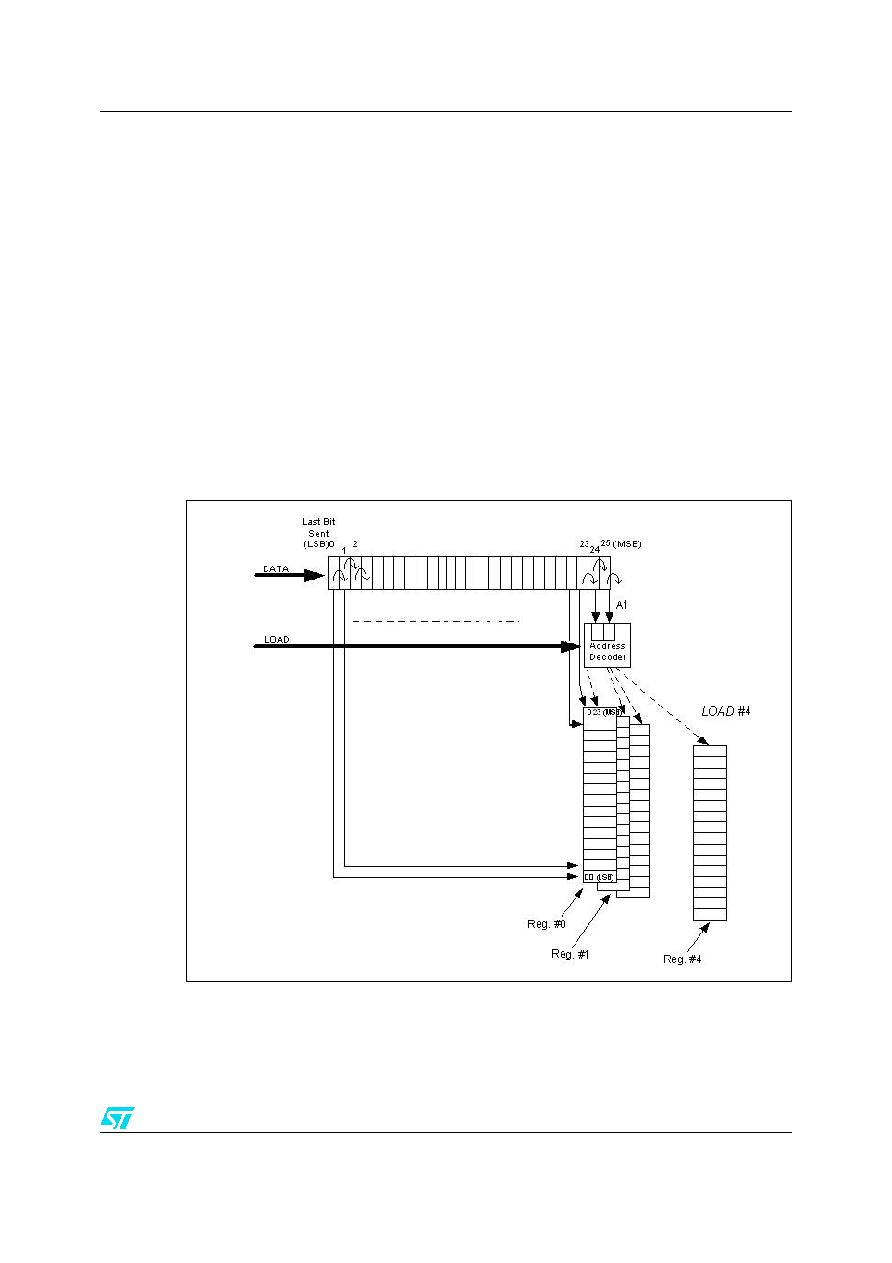
STW81101
SPI digital interface
29/42
6
SPI digital interface
6.1 General
features
The SPI digital interface is selected by hardware connection of the pin #21 (DBUS_SEL) to
3.3V.
The STW81101 IC is programmed by means of a high-speed serial-to-parallel interface with
write option only. The 3-wires bus can be clocked at a frequency as high as 100MHz to allow
fast programming of the registers containing the data for RF IC configuration.
The programming of the chip is done through serial words with whole length of 26 bits. The
first 2 MSB represent the address of the registers. The others 24 LSB represent the value of
the registers.
Each Data bit is stored in the internal shift register on the rising edge of the CLOCK signal.
On the rising edge of the LOAD signal the outputs of the selected register are sent to the
device.
Figure 22.
SPI input and output bit order

SPI digital interface
STW81101
30/42
6.2 Timing
specification
Figure 23.
SPI Timing specification
Table 17.
SPI data structure (MSB is sent first)
MSB
LSB
Address
Data for Register (24 bits)
A1
A0 D23 D22 D21 D20 D19 D18 D17 D16 D15 D14 D13 D12 D11 D10 D9
D8
D7
D6
D5
D4
D3
D2
D1
D0
Table 18.
Address decoder and outputs
Address
Outputs
A1
A0
DATABITS
D23-D0
No
Name
Function
0
0
24
0
ST1
Reference divider, VCO amplitude,
VCO Calibration, Charge Pump
current, Prescaler Modulus
0
1
24
1
ST2
Functional modes, VCO dividers
1
0
24
2
ST3
Reserved
1
1
24
3
ST4
Reserved
Table 19.
SPI Timing specification
Parameter
Description
Min.
Typ.
Max.
Unit
tsetup
DATA to CLOCK setup time
0.8
ns
thold
DATA to clock hold time
0.2
ns
tclk
CLOCK cycle period
10
ns
tload
LOAD pulse width
3
ns
tclk_loadr
CLOCK to LOAD rising edge
2
ns
tclk_loadf
CLOCK to LOAD falling edge
0.5
ns
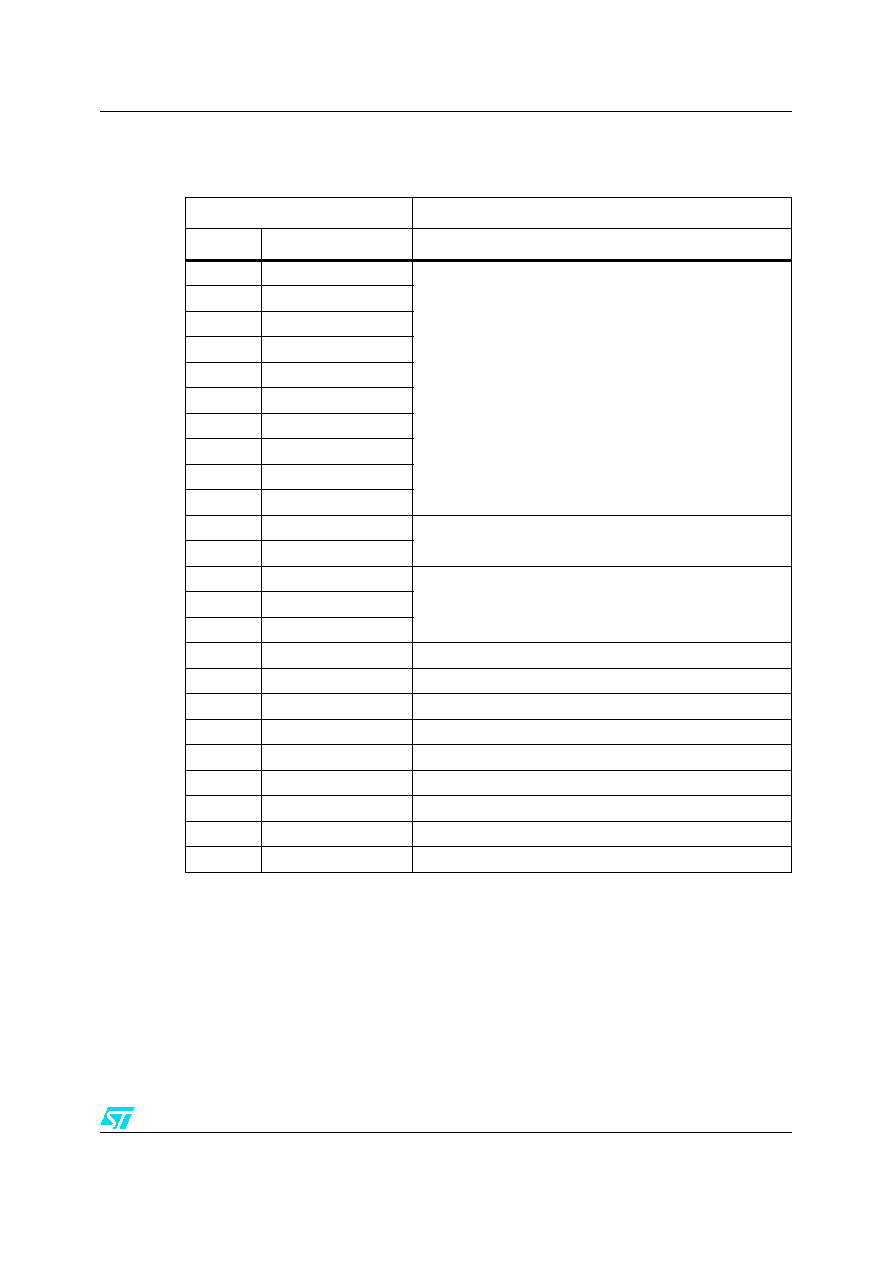
STW81101
SPI digital interface
31/42
6.3 Bits
table
Table 20.
Bits
Serial Interface Address = 00h
Register name = ST1
Bit
Name
Description
[23]
R9
REFERENCE CLOCK DIVIDER RATIO
[22]
R8
[21]
R7
[20]
R6
[19]
R5
[18]
R4
[17]
R3
[16]
R2
[15]
R1
[14]
R0
[13]
PLL_A1
VCO Amplitude Control
[12]
PLL_A0
[11]
CPSEL2
Charge Pump output current Control
[10]
CPSEL1
[9]
CPSEL0
[8]
PSC_SEL
Prescaler Modulus select (`0' for P=16, `1' for P=19)
[7]
INITCAL
test purpose only; must be set to `0'
[6]
SERCAL
Enable VCO calibration (see paragraph xxx)
[5]
SELEXTCAL
test purpose only; must be set to `0'
[4]
CAL4
test purpose only; must be set to `0'
[3]
CAL3
[2]
CAL2
[1]
CAL1
[0]
CAL0

SPI digital interface
STW81101
32/42
The LO output frequency is programmed by setting the proper value for A,B and R
according to the following formula:
and P is the selected Prescaler Modulus
[23]
PD6
DEVICE FUNCTIONAL MODES
0. Power down
1. Enable VCO A, output frequency divided by 2
2. Enable VCO B, output frequency divided by 2
3. Enable external VCO, output frequency divided by 2
4. Enable VCO A, output frequency divided by 4
5. Enable VCO B, output frequency divided by 4
6. Enable external VCO, output frequency divided by 4
7. Enable VCO A, direct output
8. Enable VCO B, direct output
9. Enable external VCO, direct output
[22]
PD5
[21]
PD4
[20]
PD3
[19]
PD2
[18]
PD1
[17]
PD0
[16]
B11
B Counter Bits
[15]
B10
[14]
B9
[13]
B8
[12]
B7
[11]
B6
[10]
B5
[9]
B4
[8]
B3
[7]
B2
[6]
B1
[5]
B0
[4]
A4
A Counter Bits
[3]
A3
[2]
A2
[1]
A1
[0]
A0
1
for Direct Output
where D
R
equals
0.5
for Output Divided by 2
0.25
for Output Divided by 4
Table 20.
Bits (continued)
Serial Interface Address = 00h
Register name = ST1
Bit
Name
Description
F
OUT
D
R
B P
A
+
(
)
F
REF_CLK
R
----------------------------
=
{

STW81101
SPI digital interface
33/42
6.4
VCO calibration procedure
The calibration of the VCO center frequency is activated by a '0' to '1' transition of the
SERCAL bit (ST1 Register bit[6]).
In order to program properly the device, ensuring the VCO calibration, the following
procedure is required before every channel change:
a)
Program the ST1 Register with the desired settings (R counter, VCO amplitude,
Charge Pump, Prescaler Modulus) and SERCAL bit set to '0'
b)
Program the ST2 Register with the desired settings (Functional mode, B and A
counters)
c)
Program the ST1 Register with the desired settings (R counter, VCO amplitude,
Charge Pump, Prescaler Modulus) and SERCAL bit set to '1'
The maximum allowed PFD frequency (f
PFD
) to perform the calibration process is 1 MHz; if
the desired f
PFD
is higher than 1MHz the following steps are needed:
≠
Perform all the steps of the calibration procedure programming the desired VCO
frequency with a proper setting of R, B and A counter so that f
PFD
is
1MHz.
≠
Program the device with the proper setting for the desired VCO and PFD
frequencies according to the above step a) and b) only.

Application information
STW81101
34/42
7 Application
information
The STW81101 features three different alternatively selectable bands: direct output (3.3 to
4.4GHz), divided by 2 (1.65 to 2.2GHz) and divided by 4 (850 to 1100MHz). In order to
achieve a suitable power level, a good matching network is needed to adapt the output
stage to a 50
load. Moreover, since most of commercial RF components have single
ended input and output terminations, a differential to single ended conversion could be
required.
Below different matching configurations for the three bands are suggested as a guideline for
the design of own application board.
The user can find in the Evaluation Kit the ADS Design for each matching configuration
suggested in this section. The name of the corresponding ADS Design is reported below
each figure.
7.1 Direct
Output
If a differential to single conversion is not needed it is possible to match the output buffer of
the STW81101 in the simple way shown in
Figure 24
.
Figure 24.
Differential/single ended output network in the 3.3 - 4.4GHz range
(MATCH_LC_LUMP_4G_DIFF.dsn)
Since most of discrete components for microwave applications are single ended, the user
can easily use one of the two outputs and terminate the other one to 50
with a 3dB power
loss.
Alternatively it is possible to combine the 2 outputs in different ways. A first topology for the
direct output (3.3GHz to 4.4GHz) is suggested in
Figure 25
. It basically consists of a simple
LC balun and a matching network to adapt the output to a 50
load. The two LC networks
shift output signal phase of -90∞ and +90∞ thus combining the 2 outputs. This topology,
designed for a center frequency of 4GHz, is intrinsically narrow band, since the LC balun is
tuned at a single frequency. If the application requires a different sub-band, the LC combiner
could be easily adjusted to be tuned at the frequency of interest.
R F
O U T P
R F
O U T N
V
C C
2nH
50 O hm
10pF
2nH
10pF
V
C C
50 O hm
50 O hm
50 O hm
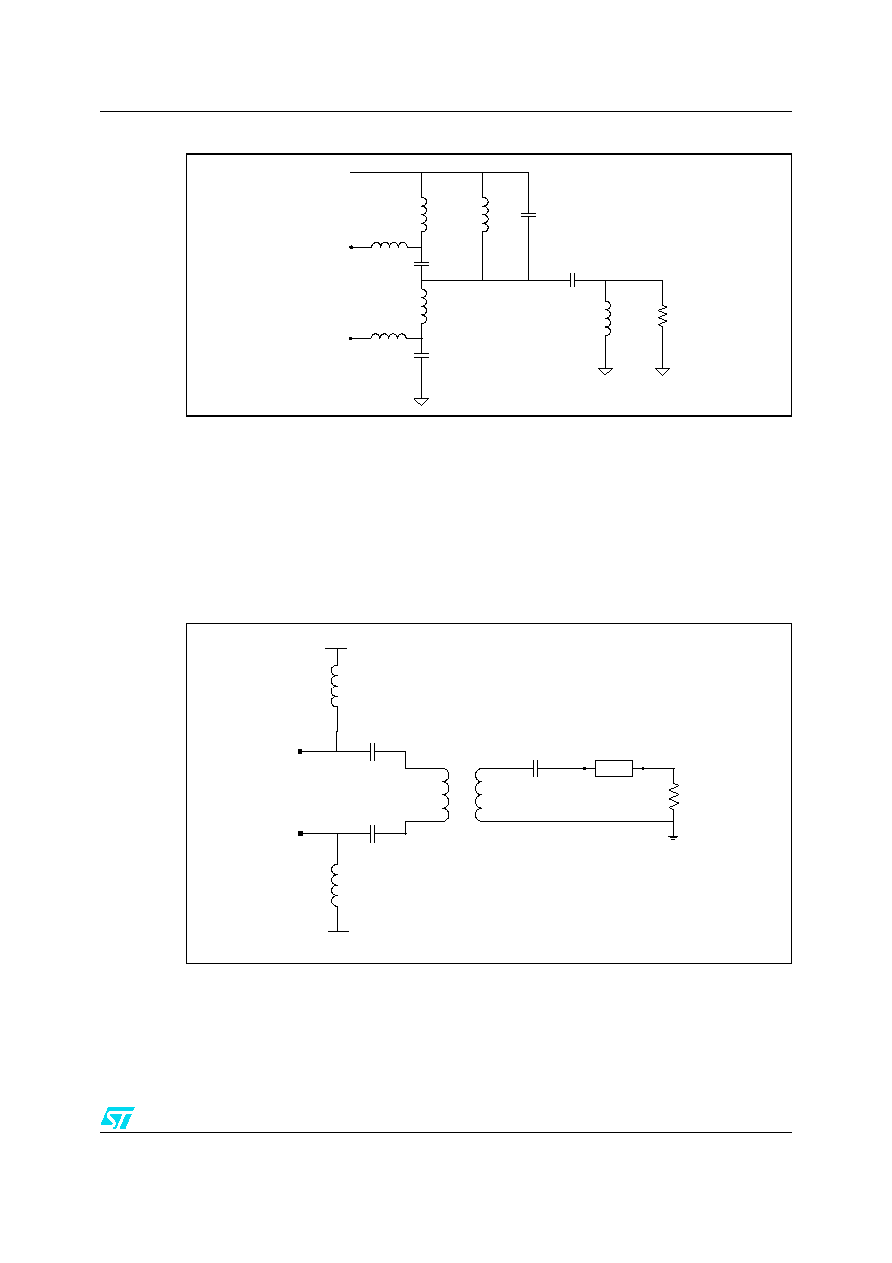
STW81101
Application information
35/42
Figure 25.
LC lumped balun and matching network (MATCH_LC_LUMP_4G.dsn)
The 6.8nH shunt inductor works as a DC feed for one of the open collector terminal as well
as a matching element along with the other components. The 1.1nH series inductors are
used to resonate the parasitic capacitance of the chip.
For an optimum output matching it is recommended to use 0402 Murata or AVX capacitors
and 0403 or 0604 HQ Coilcraft inductors. It is also advisable to use short interconnection
paths to minimize losses and undesired impedance shift.
An alternative topology, which allows for a more broadband matching and balanced to
unbalanced conversion, is shown it
Figure 26
.
Figure 26.
Microstrip line and lumped matching network (MATCH_4G_HYBRID.dsn)
Those results have been achieved on an FR4 substrate with a thickness of 350um.
By using this topology the STW81101 is capable to deliver an almost flat power to a 50
load with a return loss grater than 10dB over the whole frequency band (3.3 to 4.4GHz).
For the differential to single conversion the 50 to 100
Johanson balun is recommended
(3700BL15B100).
RF
O UTP
RF
O UTN
V
CC
1.1nH
3.6nH
0.3pF
6.8nH
0.7pF
50 Ohm
3.6nH
0.3pF
1.1nH
0.7pF
3.5nH
2:1
W=16mil
L=400mil
C=0.7pF
C=0.7pF
L=1.5nH
L=1.5nH
VCC
VCC
RFOUTP
RFOUTN
50Ohm load
C=8pF
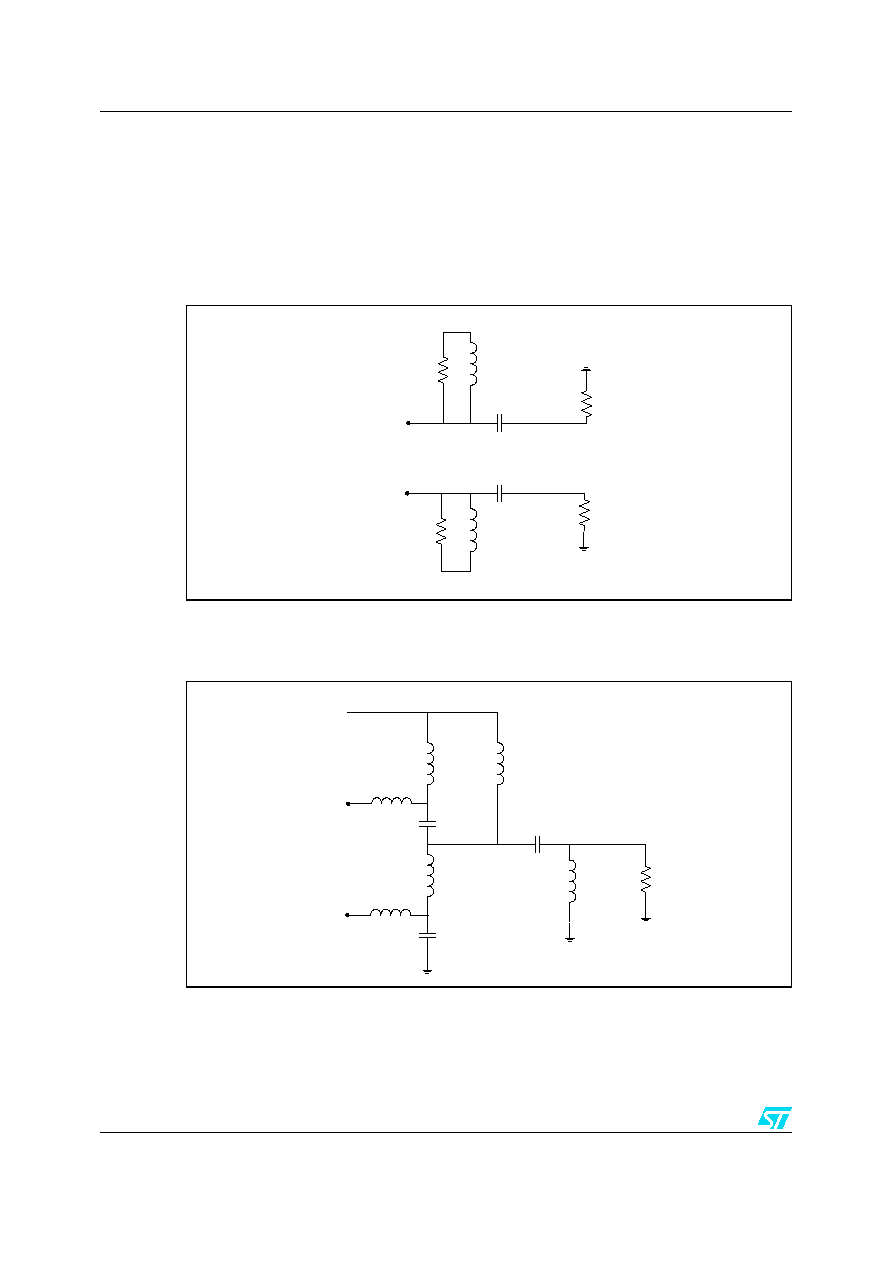
Application information
STW81101
36/42
7.2
Divided by 2 Output
If the user's application does not require a balanced to unbalanced conversion, the output
matching reduces to the simple circuit shown below (
Figure 27
).
This solution can be easily used to provide one single ended output just terminating the
other output at 50
with a 3dB power loss.
Figure 27.
Differential/single ended output network in the 1.65 - 2.2GHz range
(MATCH_LC_LUMP_2G_DIFF.dsn)
A first solution to combine the differential outputs is the lumped LC type balun tuned in the
2GHz band (
Figure 28
).
Figure 28.
LC lumped balun for divided by 2 output (MATCH_LC_LUMP_2G.dsn)
The same recommendation for the SMD components applies also for the divided by 2
output.
Another topology suitable to combine the two outputs for the divided by 2 frequencies is
represented in
Figure 29
.
RF
OUTP
RF
OUTN
V
CC
22nH
50 Ohm
10pF
22nH
10pF
V
CC
50 Ohm
50 Ohm
50 Ohm
RF
OUTP
RF
OUTN
V
CC
3nH
3nH
5.5nH
5.5nH
1pF
1pF
1nH
2.8pF
50 Ohm
2nH

STW81101
Application information
37/42
Figure 29.
Lumped output matching for divided by 2 output
(MATCH_LC_BAL_2G.dsn)
For the differential to single conversion the 50 to 100
Johanson balun (1600BL15B100) is
recommended.
7.3
Divided by 4 Output
The same topology, components values and considerations of
Figure 27
, applies also for the
divided by 4 output (MATCH_LC_LUMP_1G_DIFF.dsn).
As for the previous sections, a solution to combine the differential outputs is the lumped LC
type balun tuned in the 1GHz band (
Figure 30
).
Figure 30.
LC lumped balun for the divided by 4 output (MATCH_LC_LUMP_1G.dsn)
If the user prefers to use an RF balun it is possible to adopt the same topology depicted in
Figure 29
, just changing the balun and the resistor value (
Figure 31
). The suggested balun
for the 0.8 - 1.1GHz frequency range is the 1:1 Johanson 900BL15C050.
RF
OUTP
RF
OUTN
V
CC
22nH
50 Ohm
10pF
10pF
22nH
10pF
2:1
V
CC
50 Ohm
50 Ohm
RF
OUTP
RF
OUTN
V
CC
5.5nH
5.5nH
4pF
4pF
6pF
50 Ohm
14nH
V
CC
5.5nH
5.5nH
4pF
4pF
25 Ohm
25 Ohm

Application information
STW81101
38/42
Figure 31.
Lumped output matching for divided by 4 output
(MATCH_LC_BAL_1G.dsn)
7.4 Evaluation
Kit
Upon request an Evaluation Kit can be delivered. It includes:
Evaluation Board
GUI (Graphical User Interface) to program the device
Measured S parameters of the RF output
ADS2005 schematics providing guidelines for application board design
STWPLLSim software for PLL loop filter design and noise simulation
Three different Evaluation Kits are available, one optimized for 1GHz frequency range, one
for 2GHz frequency range and the last one for 4GHz range.
While ordering please specify the following order codes:
The three Evaluation Kits differ only regarding the output balun and the choke inductors of
the related Evaluation Board; each Evaluation Kit is provided with the needed components
(baluns and inductors) in order to easily adapt the output stage to a different frequency
range.
RF
OUTP
RF
OUTN
V
CC
22nH
50 Ohm
10pF
10pF
22nH
10pF
1:1
V
CC
25 Ohm
25 Ohm
Table 21.
Order code of the evaluation kit
Part Number
Description
STW81101-EVB1G
1GHz frequency range - Divider by 4 output optimized
STW81101-EVB2G
2GHz frequency range - Divider by 2 output optimized
STW81101-EVB4G
4GHz frequency range - Direct output optimized
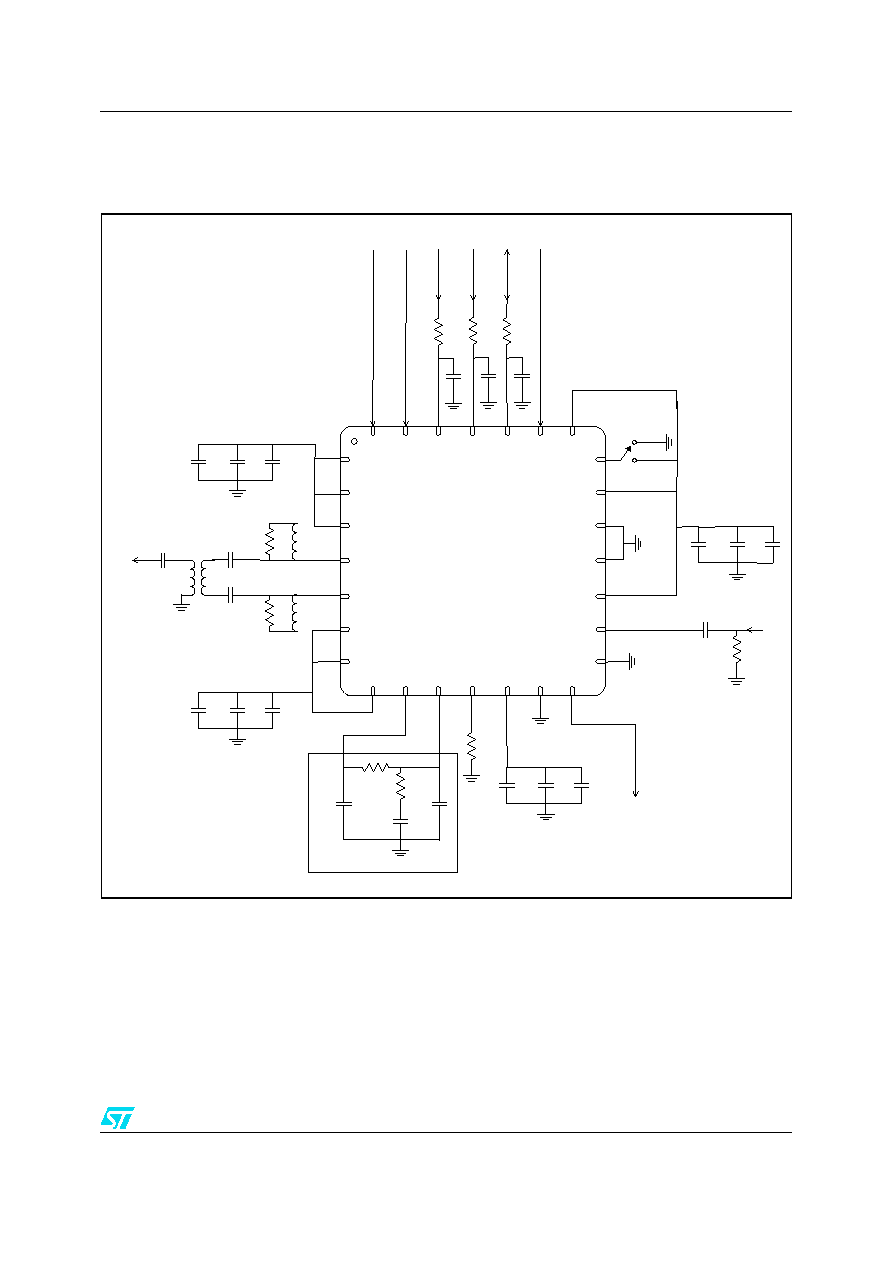
STW81101
Application diagram
39/42
8 Application
diagram
Figure 32.
Application diiagram
Note:
1
See Application Information (
Section 7
) for further information on Output Matching topology.
2
EXT_PD, ADD2, ADD1 (and ADD0 when I
2
C Bus is selected) can be hard wired directly on
the board.
3
Loop Filter values are for f
PFD
= 400KHz and I
CP
= 4mA.
V
D
D
_
ESD
VDD_VCOA
DBUS_SEL
SC
L
/
C
L
K
SD
A
/
D
A
T
A
EX
T
_
P
D
A
DD1
AD
D
0
/
L
O
A
D
A
DD2
V
DD_
DB
US
VDD_DIV2
VDD_OUTBUF
OUTBUFP
OUTBUFN
VDD_DIV4
VDD_VCOB
VC
T
R
L
IC
P
R
EXT
VD
D
_
C
P
TE
S
T
1
LO
C
K
_
D
E
T
VDD_BUFVCO
EXTVCO_INP
EXTVCO_INN
VDD_PLL
REF_CLK
TEST2
10µ
22p
1n
10µ
22p
1n
150p
220p
6.8n
10µ
22p
1n
51
1.8n
STW81101
From/to µ-controller
to
µ-controller
loop filter
VDD
1
RF Out
ref clk
VDD
1
VDD
1
VDD
1
VDD
1
VDD
2
10µ
22p
1n
I2C
SPI
1:2
100
100
15p
15p
100
15p
4.7K
8.2K
2.2K
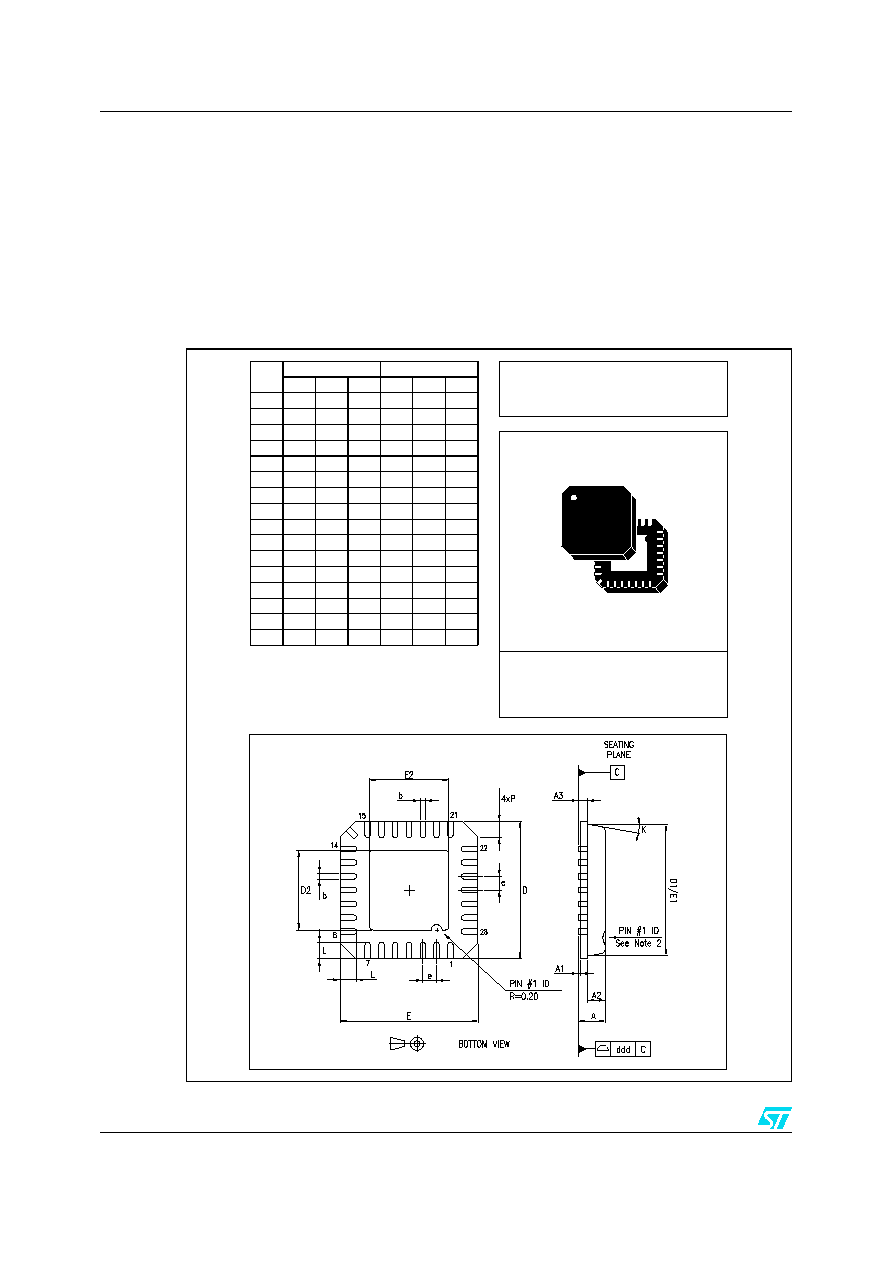
Package information
STW81101
40/42
9 Package
information
In order to meet environmental requirements, ST offers these devices in ECOPACKÆ
packages. These packages have a Lead-free second level interconnect. The category of
second Level Interconnect is marked on the package and on the inner box label, in
compliance with JEDEC Standard JESD97. The maximum ratings related to soldering
conditions are also marked on the inner box label. ECOPACK is an ST trademark.
ECOPACK specifications are available at: http://www.st.com.
Figure 33.
VFQFPN28 Mechanical Data & Package Dimensions
OUTLINE AND
MECHANICAL DATA
REF.
mm
inch
MIN.
TYP.
MAX.
MIN.
TYP.
MAX.
A
0.800
0.900
1.000
0.031
0.035
0.039
A1
0.020
0.050
0.0008 0.0019
A2
0.650
1.000
0.025
0.039
A3
0.200
0.0078
b
0.180
0.250
0.300
0.007 0.0098 0.012
D
4.850
5.000
5.150
0.191
0.197
0.203
D1
4.750
0.187
D2
2.550
2.700
2.850
0.100
0.106
0.113
E
4.850
5.000
5.150
0.191
0.197
0.203
E1
4.750
0.187
E2
2.550
2.700
2.850
0.100
0.106
0.113
e
0.500
0.020
L
0.350
0.550
0.750
0.014
0.022
0.029
P
0.60
0.0236
K
14∞
14∞
ddd
0.080
0.003
Notes: 1) VFQFPN stands for Thermally Enhanced Very thin Fine
pitch Quad Packages No lead.
Very thin: A = 1.00 Max.
2) The pin #1 identifier must be existed on the top surface
of the package by using indentation mark or other fea-
ture of package body.
Exact shape and size of this feature is optional.
VFQFPN-28 (5x5x1.0mm)
Very Fine Quad Flat Package No lead
7655832 A

STW81101
Revision history
41/42
10 Revision
history
Table 22.
Document revision history
Date
Revision
Changes
06-Mar-2006
1
Initial release.

STW81101
42/42
Please Read Carefully:
Information in this document is provided solely in connection with ST products. STMicroelectronics NV and its subsidiaries ("ST") reserve the
right to make changes, corrections, modifications or improvements, to this document, and the products and services described herein at any
time, without notice.
All ST products are sold pursuant to ST's terms and conditions of sale.
Purchasers are solely responsible for the choice, selection and use of the ST products and services described herein, and ST assumes no
liability whatsoever relating to the choice, selection or use of the ST products and services described herein.
No license, express or implied, by estoppel or otherwise, to any intellectual property rights is granted under this document. If any part of this
document refers to any third party products or services it shall not be deemed a license grant by ST for the use of such third party products
or services, or any intellectual property contained therein or considered as a warranty covering the use in any manner whatsoever of such
third party products or services or any intellectual property contained therein.
UNLESS OTHERWISE SET FORTH IN ST'S TERMS AND CONDITIONS OF SALE ST DISCLAIMS ANY EXPRESS OR IMPLIED
WARRANTY WITH RESPECT TO THE USE AND/OR SALE OF ST PRODUCTS INCLUDING WITHOUT LIMITATION IMPLIED
WARRANTIES OF MERCHANTABILITY, FITNESS FOR A PARTICULAR PURPOSE (AND THEIR EQUIVALENTS UNDER THE LAWS
OF ANY JURISDICTION), OR INFRINGEMENT OF ANY PATENT, COPYRIGHT OR OTHER INTELLECTUAL PROPERTY RIGHT.
UNLESS EXPRESSLY APPROVED IN WRITING BY AN AUTHORIZE REPRESENTATIVE OF ST, ST PRODUCTS ARE NOT DESIGNED,
AUTHORIZED OR WARRANTED FOR USE IN MILITARY, AIR CRAFT, SPACE, LIFE SAVING, OR LIFE SUSTAINING APPLICATIONS,
NOR IN PRODUCTS OR SYSTEMS, WHERE FAILURE OR MALFUNCTION MAY RESULT IN PERSONAL INJURY, DEATH, OR
SEVERE PROPERTY OR ENVIRONMENTAL DAMAGE.
Resale of ST products with provisions different from the statements and/or technical features set forth in this document shall immediately void
any warranty granted by ST for the ST product or service described herein and shall not create or extend in any manner whatsoever, any
liability of ST.
ST and the ST logo are trademarks or registered trademarks of ST in various countries.
Information in this document supersedes and replaces all information previously supplied.
The ST logo is a registered trademark of STMicroelectronics. All other names are the property of their respective owners.
© 2006 STMicroelectronics - All rights reserved
STMicroelectronics group of companies
Australia - Belgium - Brazil - Canada - China - Czech Republic - Finland - France - Germany - Hong Kong - India - Israel - Italy - Japan -
Malaysia - Malta - Morocco - Singapore - Spain - Sweden - Switzerland - United Kingdom - United States of America
www.st.com









































